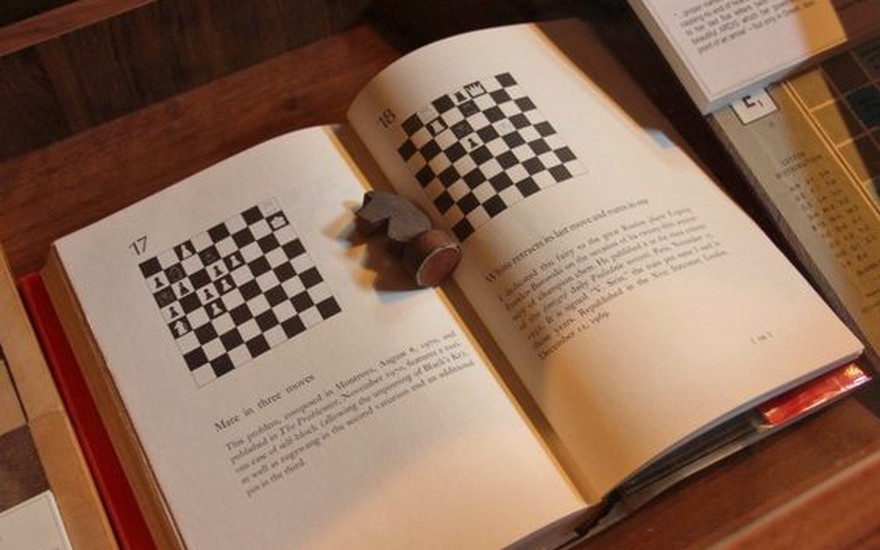
https://www.theculturemap.com/nabokov-museum-st-petersburg-literature-butterflies-chess/nabokov-chess-museum/
The Opening Anthology
You may already have an opening repertoire - but let me ask you, are those openings really the right ones for you? Or do you only play them because they're all you know?Creating an opening repertoire can be a daunting and laborious process. There are so many openings to choose from, and you really need to understand them all to ensure you're not settling for anything suboptimal. Using the knowledge I've acquired over many years of coaching and researching every opening under the sun, I'm going to take all the hard work out of the task. No matter your rating, by the end of this blog you will have a complete opening repertoire for both colours - personalised to your unique taste and style. Rather than spend copious amounts of time and money learning one particular opening to see if you even really like it, spend 20 minutes on this resource first - I assure you it's worth it. It will be like a 'choose your own adventure' book.
Every well-known opening attempts to fulfill the '3 Golden Rules' of the opening. They just go about it in different ways. The 3 Golden Rules which are the cornerstone of every succesful opening are:
- Control the centre of the board.
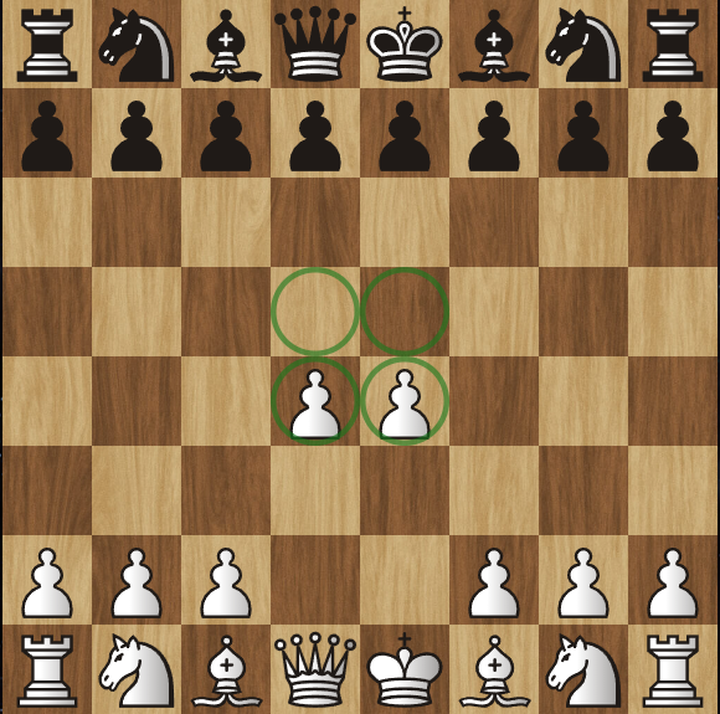
- Develop your knights and bishops.
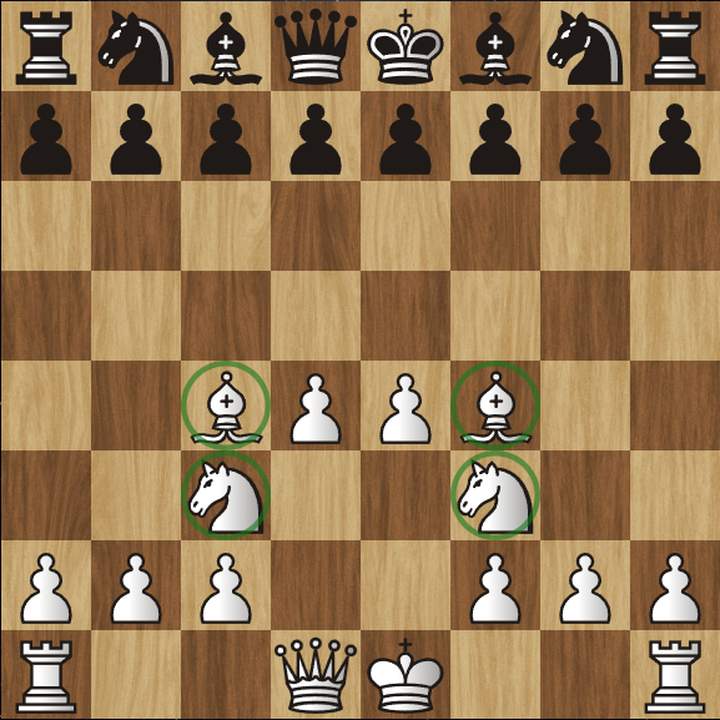
- Castle your king.
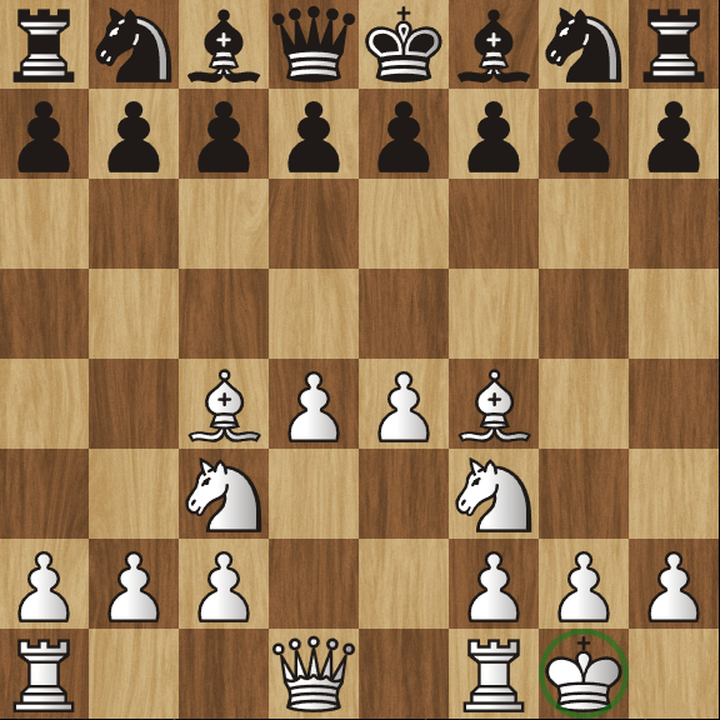
So let's start with golden rule #1:
There are a few different approaches to controlling the centre, such as from the side of the board by fianchettoing your bishop(s), but I strongly recommend you take control of it on move 1 by placing a pawn in one of the central four squares with either pawn from e2 to e4 (1.e4) or pawn from d2 to d4 (1.d4).
There are some pretty major differences between the types of positions you're likely to recieve depending on which one of those two moves you choose. Let me explain these differences. Starting with 1.e4:

1.e4 is a move that more often than not, leads to a more open, tactical game where the winner will be decided through attacks on the enemy king. It's a risky opening, where you attack your opponents king, but inevitably allow an attack against your own king. Whichever player is better at calculation, tactical awareness, sacrifices, and creativitiy will very likely come out on top. These games don't last as long, and can allow weaker players to beat stronger ones, they're very exciting, but less 'formulaic'.
On the other hand, there is 1.d4: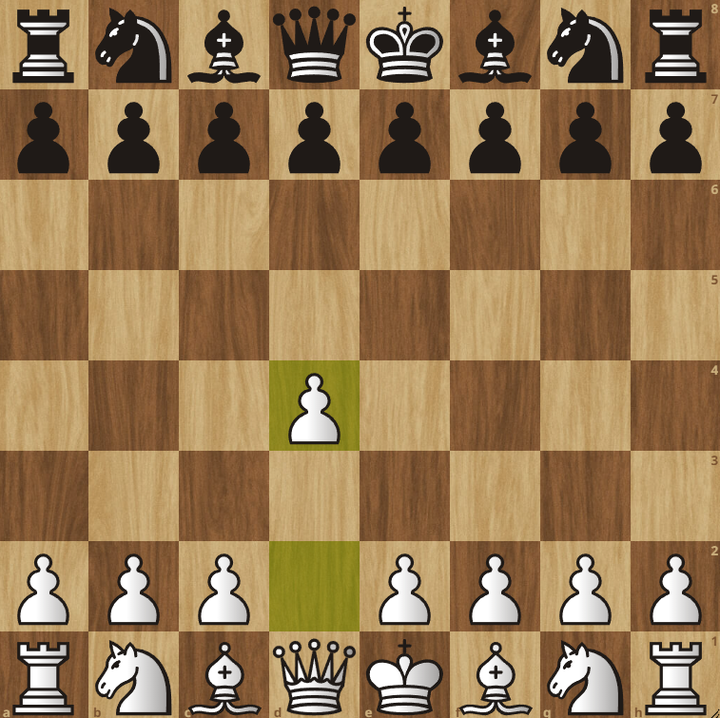
1.d4 is a much more solid, safe, strategic opening which will most likely result in a closed position (where pawns and pieces are clogged up). These positions favour the player who is better at endgames and manouvering their pieces. This opening is safer - you're not going to get checkmated at the start of the game, but you're not going to checkmate them either. These games are usually much longer than 1.e4 games, and often become decisive once they reach an endgame. Those that go to the throuble to understand and practice endgames are much more likely to safely win 1.d4 games.
So now it's time to choose between either 1.e4 and 1.d4. So to summarise: 1.e4 is more tactical, risky, aggressive, and allows for more creative 'fun' attacks, whereas 1.d4 is much more formulaic, safe, positional, and is geared towards a longer, more 'boring' game. It's important to note that there is beauty in both openings. I personally love them both. But it's very hard to learn them both at the same time, so let's just pick one.
*** Note: In all the openings that I summarise, I will also include the most commonly played moves at the Master Level from the years 2021-2023, as well as the most played moves at the <2000 Lichess level (where I will play the engine's top choice/top master move for the opening colour you're learning). ***
If you chose 1.e4 - go to Section 1.0
If you chose 1.d4 - go to Section 3.0
Section 1.0) 1.e4 e5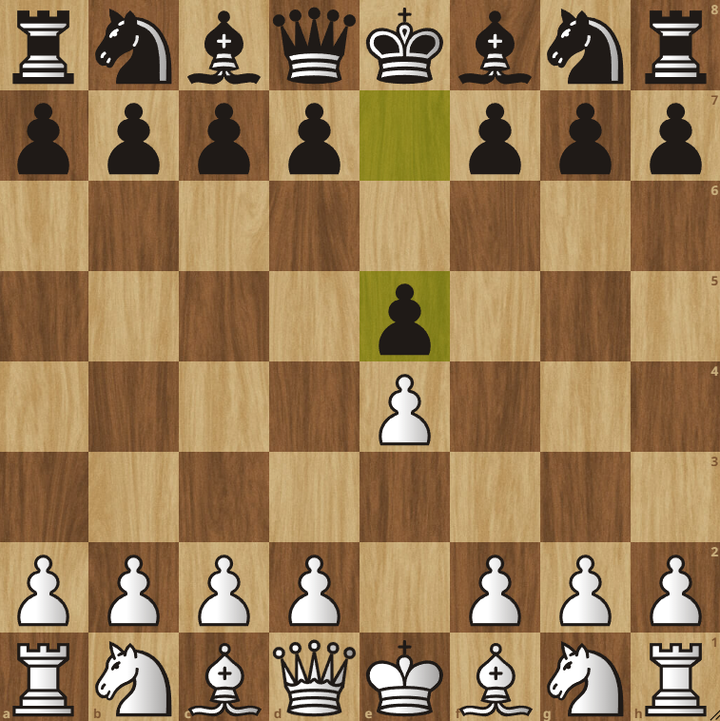
This move is the most common reply that Black plays against 1.e4 (50% of the time), so it is the one you should prepare for the most. Black's plan is simple: to stop you from playing 1.d4 as well (taking full control of the centre). There are a few options from here: You can be as aggressive as possible and sacrifice a pawn in attempt of getting an attack (gambit), or you can play a slower, and objectively better option. If you want to play a gambit, you'll have to know the opening more than your opponent, and have great calculation skill. Gambits are risky, because if you do not win quickly, you will almost certainly lose. At the highest levels, almost all gambits fail because the top players are so good at defending - but on Lichess, below the 2500 level, almost all gambits work very well if you understand them deeply.
The two good gambits that you can play after 1.e4 e5 are: the Kings Gambit (2.f4) which is probably the most aggressive opening in all of chess. You open up your king in order to launch a huge attack at the enemy king. It's very double-edged and requires a lot of study. Not recommended for beginners - but truly scary for Black if White knows their stuff. There is also the Danish Gambit (2.d4). In this opening, you will very likely gambit 2 pawns in order to develop both of your bishops, prepare to castle quickly, and gain central control. The compensation that you recieve is great, and this opening is a cheat code for lower levels, but once you cross the 2000 barrier, it get suprisingly difficult (as you are two pawns down).
Then there are two other moves, which are objectively much better (as they are not gambits). There is the Vienna (2.Nc3) which is less known and therefore can be a great suprise weopon which is flexible with a lot of nice theory to learn . This opening splits into two different variations: The Vienna Game, or the Vienna Gambit, depending on how aggressive you want to be. However, the reason it is less known is because it's not as good as the main move - 2.Nf3. Black is much more aware of this move simply because it is the best move. 2.Nf3 follows of the golden rules, and allows White to play a variety of openings (I outline four different approaches you can choose from) I strongly recommend 2.Nf3 for all players of all styles unless one of the prior options really jumped out at you.
If you would like to choose and learn more about the Kings Gambit, go to section 1.1
If you would like to choose and learn more about the Danish Gambit, go to section 1.2
If you would like to choose and learn more about the Vienna, go to section 1.3
If you would like to choose and learn more about 2.Nf3 go to section 1.4 (My Recommendation)
Section 1.1) 1.e4 e5 2.f4 "Kings Gambit"
As mentioned, this opening is one of the most aggressive and attacking in all of chess. They 'usual' game is chaos. Either you win quickly, or you lose a long painful death - that all depends on how much theory you've memorized, and how good you are at spotting and calculating tactics. After 1.e4 e5 2.f4 the game usually goes one of two ways: Black can accept the gambit with 2...exf4, which they do about 50% of the time. And the other half they decline the gambit. The most popular way to decline the gambit is with 2...Nc6, which gets played about 20% of the time. I'll leave some general theory below for you to explore to see if it's the right fit for you:
Most played line on Lichess (<2000):
1.e4 e5 2.f4 exf4 3.Nf3 Nc6?! 4.d4 d5?! 5.exd5 Qxd5 6.Nc3 Qe6+? 7.Be2 Bb4?? 8.d5 (White is winning).
Most played Master line (2021-2023):
1.e4 e5 2.f4 exf4 3.Nf3 g5 4.Nc3 d6 5.d4 g4 6.Bxf4! gxf3 7.Qxf3 Nc6 8.Bb5 (Black is slightly better).
Section 1.2) 1.e4 e5 2.d4 "Danish Gambit"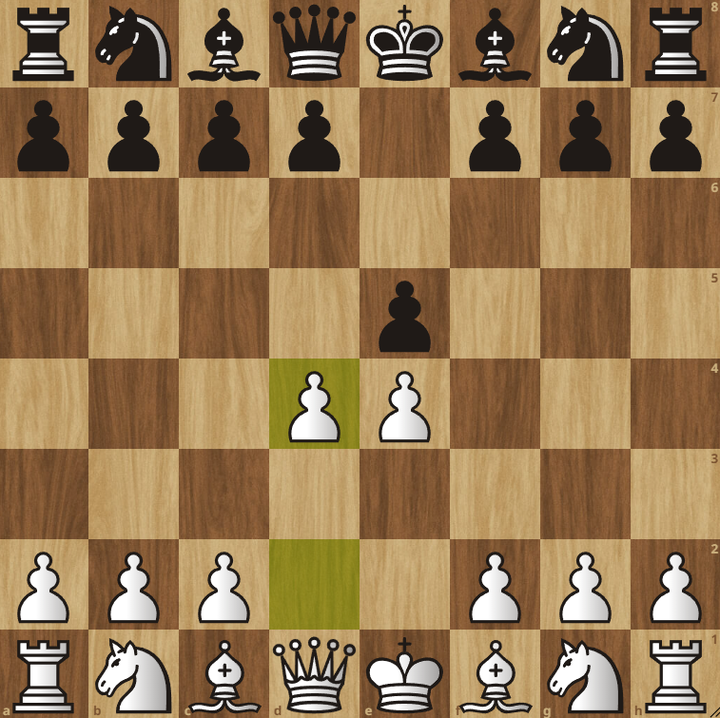
The Danish Gambit is one where you actually give up two pawns in exchange for an incredibly powerful and active bishop pair, great centre control, and get very close to being able to castle. This opening is a bit of a cheat code at the under 1800 level, allowing you to attack early, aggressively, and creatively from the get go. However, two pawns is two pawns - so at the higher levels, Black can usually defend to an endgame, where you will certainly lose as you're two pawns down (which matters a lot in an endgame). If you're good at attacking, like the kings gambit, this could be one up your alley. Comparitively, this theory isn't as heavy as the kings gambit, but will get harder and harder to play from about 1800 onwards. Still, obviously I wouldn't include it in this list if I didn't believe it had merit. As always, below are some example lines:
Most played line on Lichess (<2000):
1.e4 e5 2.d4 exd4 3.c3 dxc3 4.Bc4 cxb2 5.Bxb2 Bb4+ 6.Nc3 Nf6 7.Qb3 Bxc3 8.Qxc3 (Black is slightly better).
Most played Master line (2021-2023):
1.e4 e5 2.d4 exd4 3.c3 d5 4.exd5 Qxd5 5.cxd4 Nc6 6.Nf3 Bg4 7.Be2 Bb4+ 8.Nc3 (Equality)
Section 1.3) 1.e4 e5 2.Nc3 "Vienna"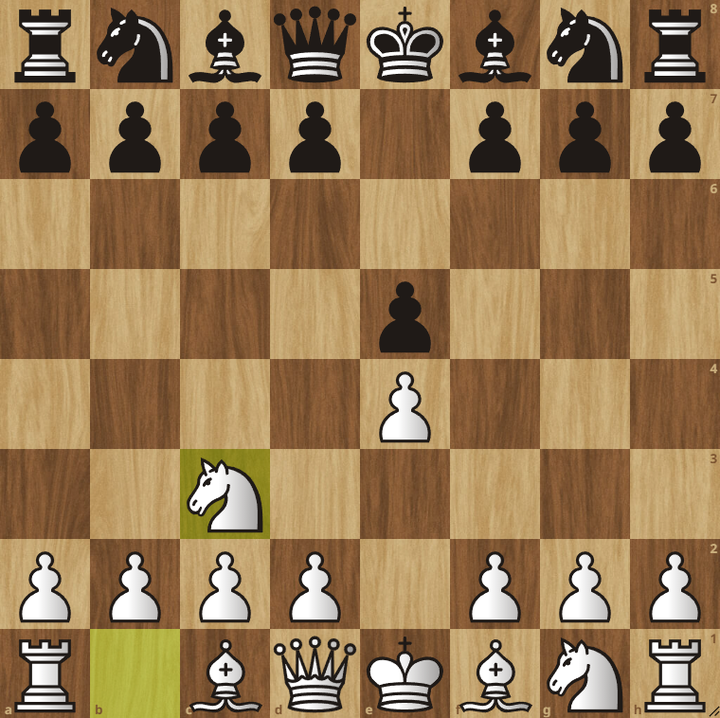
The Vienna, is a very flexible opening which allows White to play in two different ways - they can play a gambit with 3.f4 (Vienna Gambit), sort of like a delayed kings gambit, which is a very nice attacking chocie with slightly less risk than the Kings Gambit, with lots more intuitive play. But White can also play a much safer option with 3.Bc4 (Vienna Game), which is a much safer opening to build up an attack. It often leads to interesting tactical and dynamic positions which Black isn't likely to be familiar with.The Vienna is a flexible alternative to the much better known 2.Nf3 lines..
Most played line on Lichess (<2000):
1.e4 e5 2.Nc3 Nf6 3.f4 exf4 4.e5 Ng8 5.Nf3 d6 6.d4 dxe5 7.Bb5+ c6 8.Bc4 (White is better).
Most played Master line (2021-2023):
1.e4 e5 2.Nc3 Nf6 3.Bc4 Nc6 4.d3 Na5 5.Nge2 Nxc4 6.dxc4 Bc5 7.Qd3! d6 8.Be3 (White is slightly better).
Section 1.4) 1.e4 e5 2.Nf3 Nc6
2...Nc6 is Black's best reply, and the one you will see 60% of the time online. As a basic rule of thumb, whatever other move Black plays, you should either play 2.d4, or exchange pawns. It's the one you really need to prepare for. And there's 4 moves I'm going to recommend from here...
The first is the 'Ruy Lopez', which is a classical, positional opening, which is known for its rich strategic possibilities, allowing for both aggressive and solid set ups, acting as a great versatile foundation for all styles. It's incredibly popular at the highest level.
Second is the 'Italian Game', which is similar to the Ruy Lopez, but a little more dynamic and aggressive. It has a lot of emphasis on rapid development, and potential attacks on the f7 square. If you want to play aggressively, there are many dynamic possibilities, but there are also lots of strategical maneuvering, just a little more symettrical, and therefore a little harder to create chances with if you choose to more quiet style of the opening. This opening is played just as much as the Ruy Lopez at the top level nowadays.
Third is the 'Scotch', which leads to very open positions, and can go one of two ways - White can play the 'Scotch Game', which opens up the centre, and attempts to quickly develop pieces and create imbalances in the position and take strong control of the centre. But you can also choose to play the 'Scotch Gambit', which leads to very quick development, and specifically, an attack on the enemy king, making it hard for Black to devlop. This opening has a ridiculously high win rate at the sub-2000 level. At the highest level, it's played a lot less than the Ruy Lopez and Italian, though.
Finally, I will recommend the 'Ponziani', which is a much rarer opening, taking an extra move to dominate the centre. This opening prioritises getting pawns in the centre, which gives Black an extra move to prepare for such an event. But as it turns out, the only way Black can stop White's central dominance is to play a very ugly positional move, or very complicated sacrifice. These options are neither intuitive, or playable at the sub-2400 level, and therefore wins very quickly and easily. Because it is rare, not many Black players know how to counter it. Though at the top level, it's virtually never played.
If you're interested in the Ruy Lopez, go to Secion 1.5
If you're interested in the Italian, go to Section 1.6
If you're interested in the Scotch, go to Section 1.7
If you're interested in the Ponziani, go to Section 1.8
Section 1.5) 1.e4 e5 2.Nf3 Nc6 3.Bb5 "Ruy Lopez"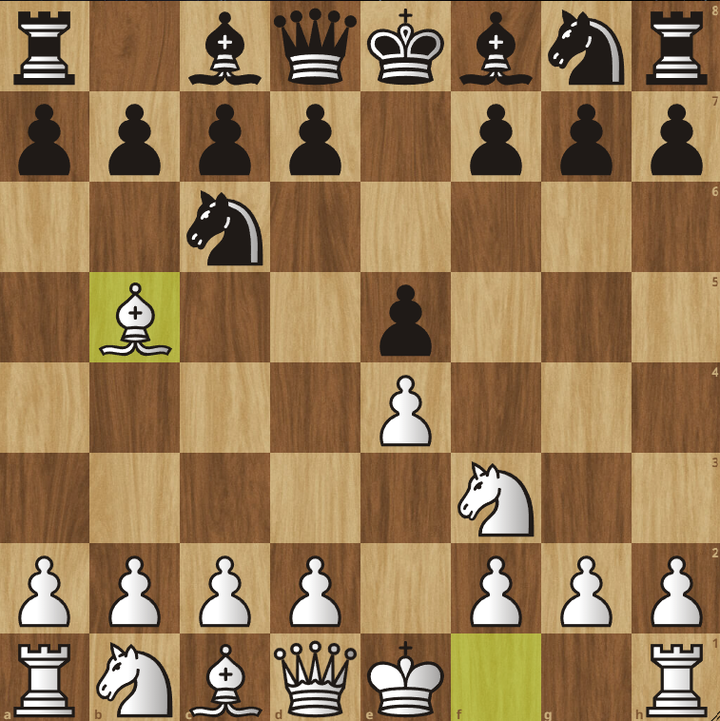
The Ruy Lopez is a very rich classical opening with lots of tactical and strategic possibilities. It is quite flexible, leading to both open and closed positions. It immediately attempts to solve the golden rules by castling early, and indirectly controls the centre by somewhat preventing Black from play pawn to d6, as this would pin the c6 knight. The Ruy Lopez has been extensively studied for centuries, and there are many famous games to learn from in this opening. It is one of the most respected openings in chess. One very common idea after 1.e4 e5 Nf3 Nc6 3.Bb5 Nf6, let's say, is to play 4.O-O allowing Black to take the e4 pawn. Now if 4...Nxe4 (which is the best move, but so hard to play), 5.Re1 hits the knight, and points in the direction of the king. Black needs to play the unintuitive 5...Nd6 (blocking the d-pawn), but what usually happens instead, is 5...Nf6? which is a mistake, usually resulting in a loss after 6.Nxe5 Nxe5?? 7.d4! which looks like it's just a trade, but in reality, White is winning. The Ruy Lopez is very complex and rich, as mentioned. Continuing on, the most common line on Lichess continues: 7...c6 8.dxe5 cxb5?? 9.exf6 Be7 10.Rxe7+ Kf8 11.Qd6! gxf6 12.Bh6+ Kg8 13.Qg3#. A little warning about the amount of theory you need to memorise in order to become a master of the opening: A LOT. Because it's such a strong, old opening, Black has developed many variations in an attempt to face it, some worse than others, but all with some merit. Although White can get by just learning the typical maneuvering ideas with c3 & d4, Nbd2-f1-g3, a4, Re1, and h3 - if White really wants to take it seriously, they need to learn so much more. Lastly, though, if you do learn your theory, and the meaning behind it, you'll often beat Black straight out of the opening by a detail as seemingly insignificant as move order.
Most played line on Lichess (<2000):
1.e4 e5 2.Nf3 Nc6 3.Bb5 a6 4.Ba4 b5 5.Bb3 Nf6 6.O-O Bc5 7.c3 O-O? 8.d4 (White is better)
Most played Master line (2021-2023):
1.e4 e5 2.Nf3 Nc6 3.Bb5 a6 4.Ba4 Nf6 5.O-O Be7 6.Re1 b5 7.Bb3 O-O 8.c3 (White is slightly better).
Section 1.6) 1.e4 e5 2.Nf3 Nc6 3.Bc4 "Italian"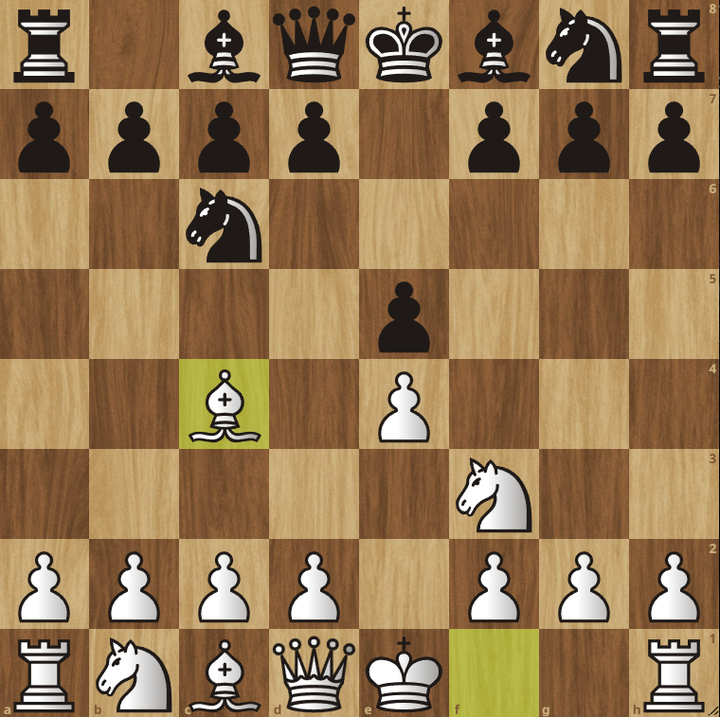
The Italian is a very versatile opening which White can play in a number of ways depending on how sharp or positional they want to make the position. Black on the other hand, essentially has only 2 options after 3.Bc4 - that is 3...Bc5 or 3...Nf6. Luckily for Black, both of these moves will almost certainly give Black equality or better if they know their theory back to front. Trouble is, in both of these approaches, White can continue choosing from a variety of different options, making Black's job of memorizing theory quite difficult. Many natural moves in this opening get punished, so Black really has to know their stuff. After 3...Nf6, White can go for the aggressive and dynamic 4.Ng5 attempting to go into a variation called the 'Fried Liver Attack', which occurs after 4...d5 5.exd5 Nxf5? 6.Nxf7!, but otherwise settling for a number of different options after 5...Na5! 6.Bb5+ c6 7.dxc6 bxc6 including the aggressive 8.Qf3!?. Otherwise, if Black chooses 3...Bc5, then White can either go for the quiet and deeply strategical 'Giuoco Pianissimo' with 4.c3 Nf6 5.d3 (which you can also transpose into from the 3...Nf6 line after 4.d3 Bc5 5.c3), or you can go for some more dynamic aggresive options such as the 'Centre Attack' which from 3...Bc5 occurs after 4.c3 Nf6 5.d4 exd4 6.e5. Or the 'Aitken Variation' which from 3...Bc5 occurs after 4.c3 Nf6 5.d4 exd4 6.cxd4. Finally, you could try the 'Evans Gambit', which from 3...Bc5 occurs after 4.b4!?. The Italian is very versatile, and has a lot of theor to memorise for both sides. It's a very respectable opening, too. But obviously can be hard to play for both sides.
Most played line on Lichess (<2000):
1.e4 e5 2.Nf3 Nc6 3.Bc4 Nf6 4.Ng5 d5 5.exd5 Nxd5? 6.Nxf7! Kxf7 7.Qf3+ Ke8? 8.Bxd5 Nd4?? 9.Qf7#
Most played Master line (2021-2023):
1.e4 e5 2.Nf3 Nc6 3.Bc4 Bc5 4.c3 Nf6 5.d3 d6 6.O-O O-O 7.Re1 a5 8.h3 (Equality)
Section 1.7) 1.e4 e5 2.Nf3 Nc6 3.d4 "Scotch"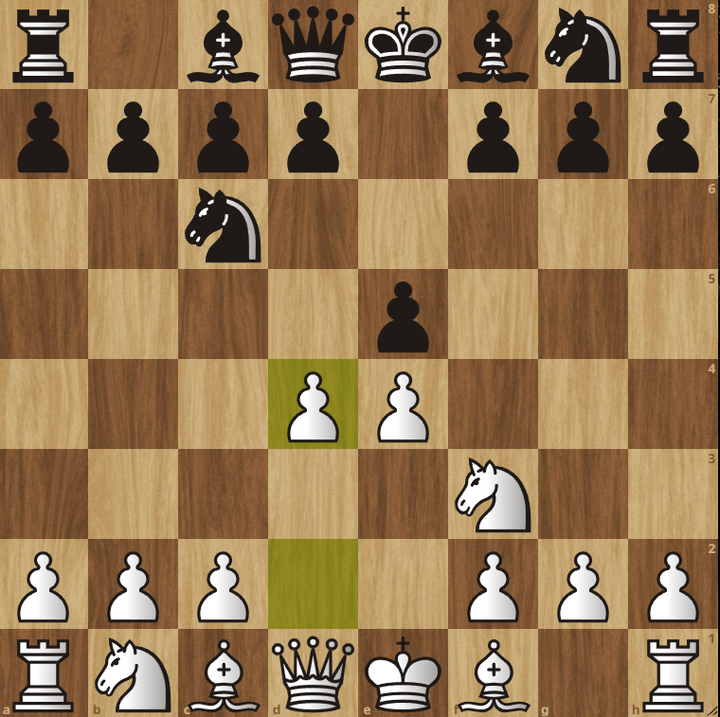
The Scotch is another versatile opening, which allows for aggressive attacks, as well as more open strategical battles. I would compare it to the Italian in that the aggresssive lines aren't quite as forcing or hard to work out, but the strategical battles are much mor dynamic, open, and confusing, as many imbalances immediately get creating, leading to very rich middlegames and plenty of chances get created for both sides throughout the entire game. If you're good at spotting tactical oppertunities (both offensively and defensively), and you enjoy fresh new positions that allow for creative ideas, then this is the opening for you. There will be plenty of chances, and both sides need to be very careful. It's not played as much as the Italian and Ruy and any level, but still gets played here and there. White has the option to go into the 'Scotch Game' after 3...exd4 with 4.Nxd4. Or they can gambit the pawn for the more aggressive 4.Bc4 - 'Scotch Gambit'. The latter opening has the highest win rate at the <2000 level, with 70% of players falling into a trap in the first 10 moves. But obviously a well prepared 1...e5 player will gain equality fairly easily.
Most played line on Lichess (<2000):
1.e4 e5 2.Nf3 Nc6 3.d4 exd4 4.Bc4 Bc5?! 5.c3 dxc3? 6.Bxf7+! Kxf7 7.Qd5+ Ke8 8.Qh5+! (White is better)
Most played Master line (2021-2023):
1.e4 e5 2.Nf3 Nc6 3.d4 exd4 4.Nxd4 Nf6 5.Nxc6 bxc6 6.e5 Qe7 7.Qe2 Nd5 8.c4 (Equality)
Section 1.8) 1.e4 e5 2.Nf3 Nc6 3.c3 "Ponziani"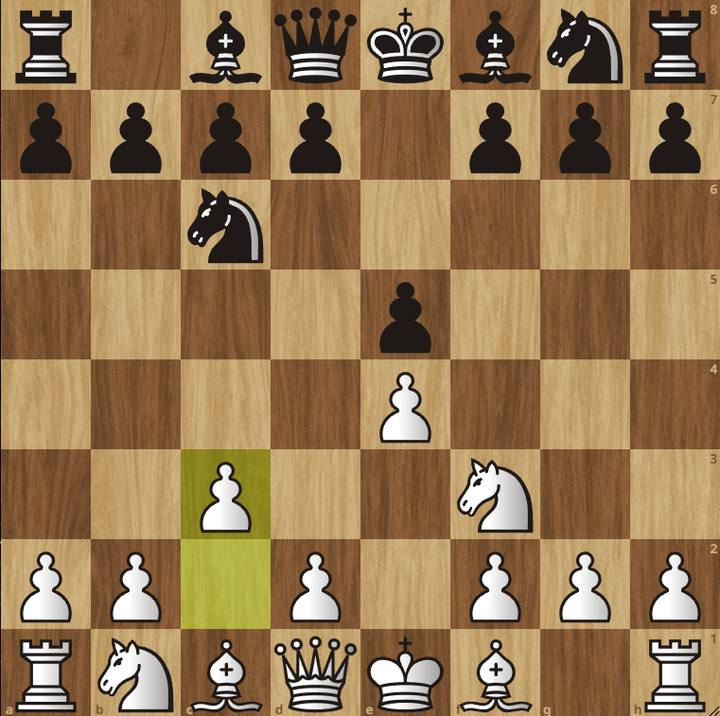
The Ponziani is a rare opening which many 1...e5 players aren't prepared against. I wrote a free Chessable course on this opening, and I can tell you, lots of people are aware this opening doesn't have a great reputation, and therefore don't study against it. However, it's incredibly tricky. All of White's moves that lead to winning positions are very natural and easy to find, however Black's best moves which don't lose are very unintuitive and hard to find. When White plays 3.c3 they temporarily take away the ideal square for the b1-knight, but prepare to take over the centre with 4.d4. The three most played moves are 3...Nf6 (which gives White immediate equality), 3...Bc5? (which immediately gives a large edge to White), and 3...d5 (the best move, but makes the game very hard to navigate for Black). If 3...Nf6, White will play 4.d4, and whichever central pawn Black takes, White will push forward with the other central pawn - gaining the centre, as well as allowing Black to blunder immediately if after 3...Nf6 4.d4 Nxe4 5.d5 Ne7 6.Nxe5 d6?? 7.Bb5+! winning. If 3...Bc5? White will play 4.d4 which gives White a strong centre and an easy game. We're not concerned about 4...Bb4+ because of 5.Nc3, then lets say 5...Nf6 6.Bd3, Black's most common move is to blunder with the natural 6...O-O?? which loses because of 7.e5 followed by Bxh7+! - a nasty greek gift sacrifice. Finally, with 3...d5 White replies with 4.Qa4! and now Black must find 4...f6! to hold a slight advantage. I have played many masters who know 3...d5 but no further, and end up losing within the next 3 moves. This opening won't get great positions for either side at the highest level, but below the 2400 level on Lichess, this opening will, 70% of the time, win within 10 moves. I highly recommend it if you're willing to put in a bit of study to remember the key lines to punish Black's natural blunders.
Most played line on Lichess (<2000):
1.e4 e5 2.Nf3 Nc6 3.c3 Nf6 4.d4 exd4 5.e5 Nd5 6.cxd4 Bb4+ 7.Nbd2 O-O 8.a3 (Equality)
Most played Master line (2021-2023):
1.e4 e5 2.Nf3 Nc6 3.c3 d5 4.Qa4! f6! 5.d3 Be6 6.Be3 Qd7 7.Nbd2 Nge7 8.d4 (Black is slightly better).
Continuing on to if Black doesn't reply with 1...e5 you must be prepared against:
Section 2.0) 1.e4 c5 "Sicilian Defense"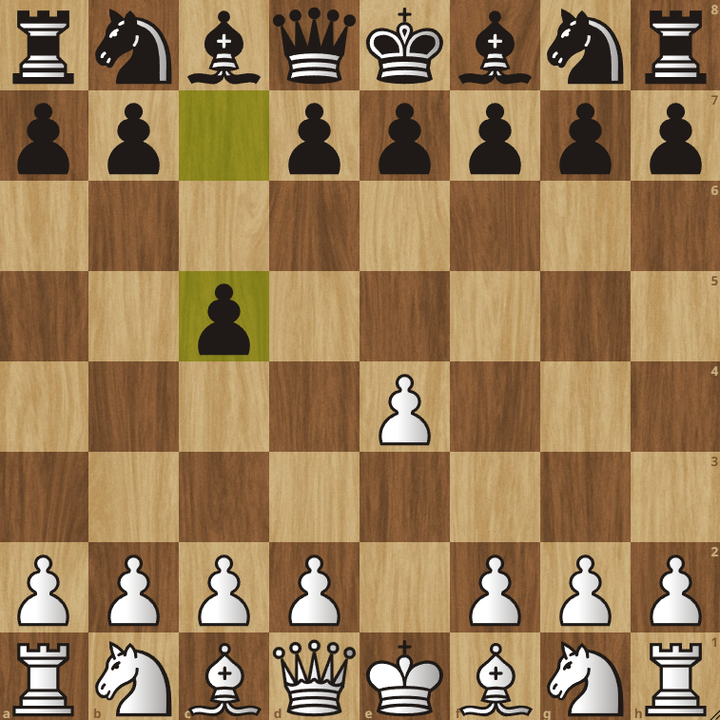
The Sicilian is Black's other move to prevent White from playing 2.d4 effectively, played 20% of the time. It is very sharp and tactical, which allows for creative sacrifices and dynamic imbalances. Black's plan is to give up control of the centre in order to trade off their c-pawn (flank pawn) for White's d-pawn (central pawn). Because of this, over the course of the game, Black will have more potential to control the centre with their 2 pawns. This opening creates many imbalanaces and key squares which, strategically the game usually becomes focussed around depending on the variation. There is a lot of theory in the Sicilian, and many variations favouring all different styles. In the most common mainlines, the game usually continues with Black castling kingside (because it's hard to castle queenside without a c-pawn). Because of this, White castles queenside in order to launch their kingside pawns up the board to checkmate Black (because they can't efffecitvely move their kingside pawns if they castle kingside as it would open their king in the process). This prompts Black to counterattack by throwing their queenside pawns up the board towards the White king, and using the semi-open c-file to create dangerous counterattacks. Here are White's main options:
White can play the most common and commonly accepted best move with 2.Nf3 followed by 3.d4 in order to reach those common mainlines I was talking about. This is called the 'Open Sicilian' and it's what virtually all GMs play. Otherwise, they can try their luck with a lesser-known sideline which is objectively slightly worse, but could win very quickly if Black doesn't know their theory. These are called "Anti-Sicilians" and include: 2.c3 the 'Alapin' which is where White attempts to take over the centre quickly, but temporarily blocks their b1-knight from it's optimal square. Black's natural moves once again get punished, but if Black knows their theory, they can equalise fairly easily, the alapin gets played rarely at the top level. Then there is 2.Nc3 the 'Closed Sicilian' which is a much more solid, classical alternative to the open sicilian where White either plays in a very solid manner with g3 and Bg2, or tries to launch an early kingside attack with f4, this gets plays now and then at the top level. Finally, there is the 'Smith-Morra Gambit' with 2.d4?! and after 2...cxd4 3.c3, this gambit is extremely tricky with many sharp fun lines that in exchange for one pawn, give White plenty of creative attacks that are very hard to defend against, unless Black really knows their stuff, of course. This options virtually never gets played at the top level, but is often succesful just below the top level.
If you're interested in the Open Sicilian, go to Secion 2.1 (My recommendation)
If you're interested in the Alapin, go to Section 2.2
If you're interested in the Closed Sicilian, go to Section 2.3
If you're interested in the Smith-Morra Gambit, go to Section 2.4
Section 2.1) 1.e4 c5 2.Nf3 "Open Sicilian"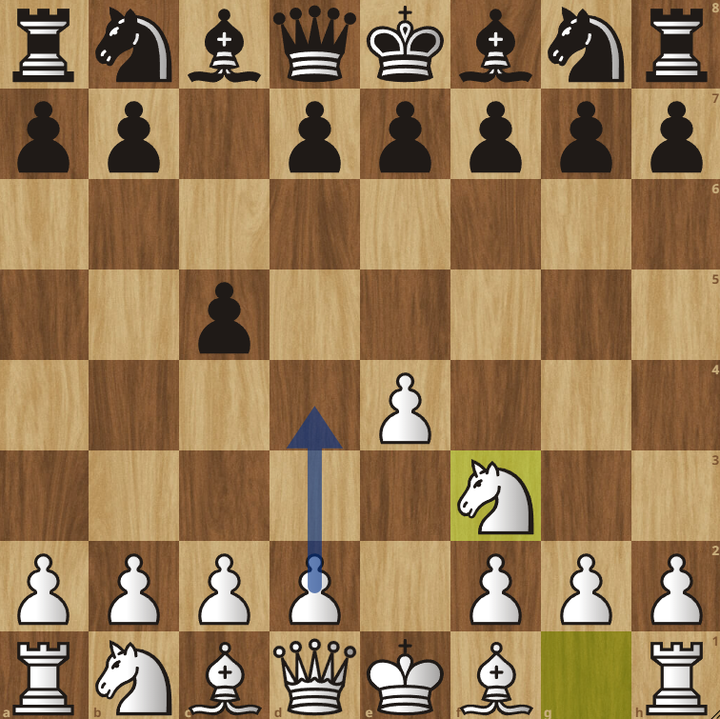
The Open Sicilian is White's best approach to facing 1...c5. However it can be very difficult to play, because although White's plans are usually the same (castle queenside and launch the kingside pawns), they need to be prepared against the sharp counterattack which Black will throw at them on the queenside, as well as the naunces which are slightly different in the many variations that Black can employ. There are about 20 variations you need to know how to handle slightly differently if you're a serious top player. But if you know your theory and the basic ideas behind every variation, then you will always end up on top - or at least slightly better in an obviously complex position. If you like creative, dynamic, attacking positions, and you've got a good memory, definitely play the Open Sicilian. Playing this opening also gets you all sorts of different positions, which teaches you a lot about chess. After 1.e4 c5 2.Nf3 Black has three popular options (2...Nc6, 2...d6 & 2...e6), but no matter which one they play, we will play 3.d4, they will take with 3...cxd4, then 4.Nxd4 and they will either play 4...Nf6, 4...Nc6, or 4...e5, our plans will differ slightly in where we put our knights, and whether we insert c4, but we will almost always castle queenside, then push our kingside pawns up the board and look for attacking sacrifices. The reason we castle queenside and push kingside, is because as soon as Black plays a Sicilian, they're basically saying "I'm going to casled kingside" (As castling queenside would lead to an open king due to the semi-open c-file). So we preemptively push on the kingside and centre (which means we will have to castle queenside to not expose our own king.
Most played line on Lichess (<2000):
1.e4 c5 2.Nf3 Nc6 3.d4 cxd4 4.Nxd4 e5 5.Nb5 d6 6.N1c3 a6 7.Na3 b5 8.Nd5 (White is slightly better).
Most played Master line (2021-2023):
1.e4 c5 2.Nf3 d6 3.d4 cxd4 4.Nxd4 Nf6 5.Nc3 a6 6.Be3 e5 7.Nb3 Be6 8.f3 (White is slightly better).
Section 2.2) 1.e4 c5 2.c3 "Alapin"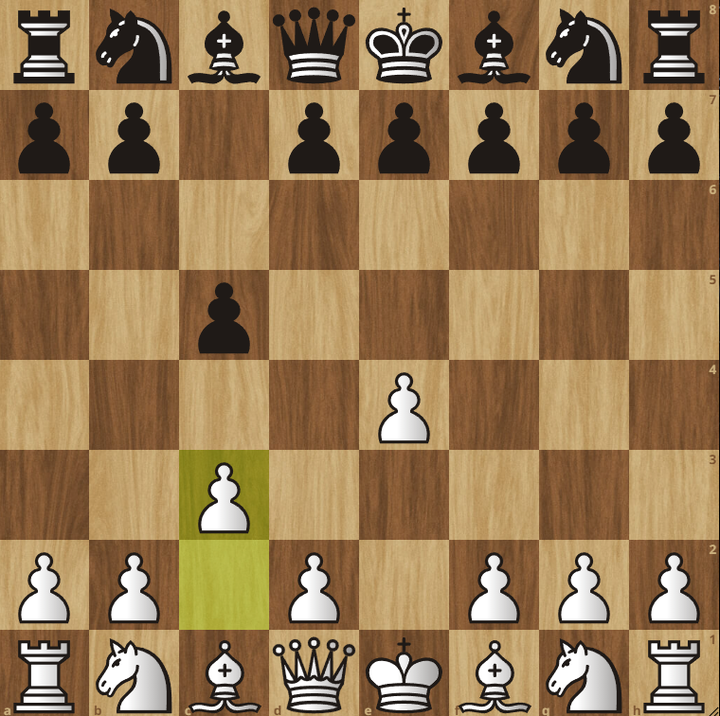
The Alapin is a very tricky, and easy to play anti-sicilian alternative to the heavy theory of 2.Nf3. With 2.c3, White attempts to immediately fight against the Black's flank pawn without losing a pawn in the centre. However in doing so, they give Black a little bit of time to prepare, as it is a little harder for White to develop quickly into the centre (for example, their b1-knight is blocked). Black has two main options from here - the attempt to punish White with the engine's top choice - 2...d5, and allowing White to take the centre, but then counterattacking with a timely d6, with 2...Nf6. But at the lower levels, Black often goes wrong immediatley, underestimateing White's threat, when they play 2..Nc6?!, which allows 3.d4 and after 3...cxd4 4.cxd4 White is left with the centre, about to play d5, harrasing the knight (and players below 2000 usually don't know how to deal with this threat effectively.
Most played line on Lichess (<2000):
1.e4 c5 2.c3 Nc6?! 3.d4 exd4 4.cxd4 e6?! 5.d5! exd5 6.exd5 Ne5 7.Qe2!? d6?? 8.f4 (White is winning).
Most played Master line (2021-2023):
1.e4 c5 2.c3 Nf6 3.e5 Nd5 4.Nf3 Nc6 5.d4 cxd4 6.cxd4 d6 7.Bc4 Nb6 8.Bb5 (Equality).
Section 2.3) 1.e4 c5 2.Nc3 "Closed Sicilian"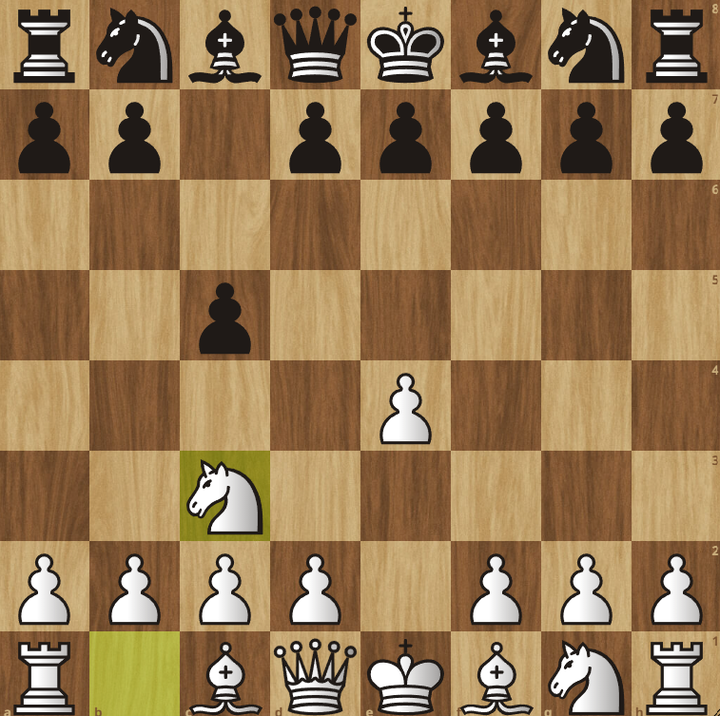
The Closed Sicilian is an interesting alternative to the Open Sicilian, which can be compared to the Vienna vs. the 2.Nf3 lines against 1...e5. It's very similar in the fact that there are two different ways to play it - one with a safe solid approach with g3 and Bg2 (Traditional), and a more aggressive option with an early f4 (Grand Prix Attack). With the traditional approach with g3 and Bg2, White attempts to enter a strategical battle, rather than a tactical one. It is also much lesser known and quieter than the open sicilian. It offers lots of strategical oppertunities for both sides, including pawn structure manipulation and long-term positional advantages depending on who knows it better - which will very likely be you as Black must prioritise the more popular 2.Nf3. The Grand Prix Attack with 3.f4 usually continues with the plan of 4.Nf3 5.Bb5 or Bc4 6.d3 7.O-O 8.Qe1-g3 with an easy kingside attack. Whereas the Traditional Variations with g3 and Bg2 usually go: 3.g3 g6 4.Bg2 Bg7 5.d3 d6 and White's main options are either 6.Be3 followed by Qd2 and possibly 0-0-0, or 6.f4 followed by Nf3 and 0-0.
Most played line on Lichess (<2000):
1.e4 c5 2.Nc3 Nc6 3.f4 e6 4.Nf3 d5 5.Bb5 d4?! 6.Bxc6+ bxc6 7.Na4 Nf6 8.O-O! (White is slightly better)
Most played Master line (2021-2023):
1.e4 c5 2.Nc3 Nc6 3.Bb5 Nd4 4.Nf3 a6 5.Bd3 g6 6.O-O Bg7 7.Re1 Nxf3+ 8.Qxf3 (Equality).
Section 2.4) 1.e4 c5 2.d4 "Smith-Morra Gambit"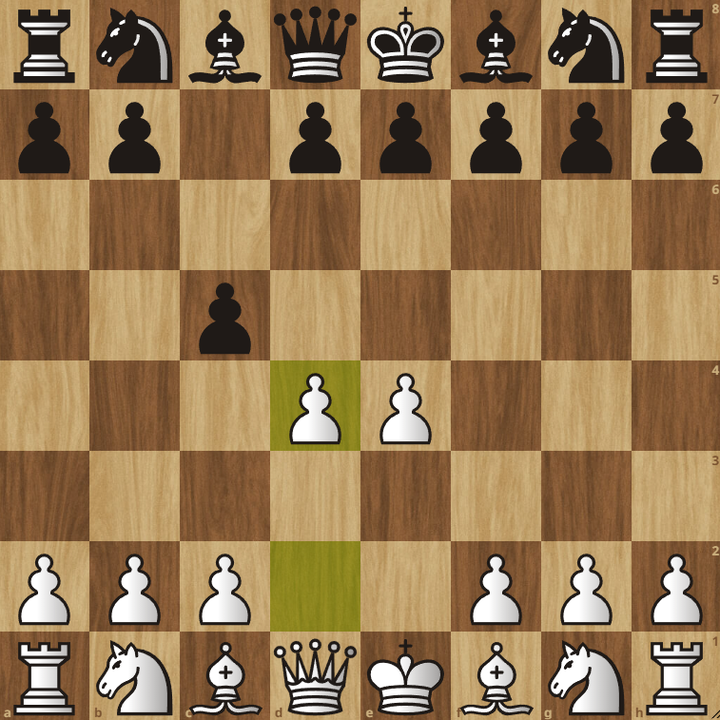
The Smith-Morra Gambit is the most tricky and aggressive of all the anti-sicilians. White hopes to get rapid development of their pieces to start an attack on the enemny king. Black needs to be suprisingly book up, even at the top level, to get a better position. Of course, if Black knows all their theory, they will get a better position. But it's very hard to memorise all the theory even for a Sicilian expert against a line as rare as the Smith-Morra. There are many depp creative and thematic sacrifices which White can play in most positions to get crushing advantages that White may not be aware of - like Nd5. These lines are very fun and tricky, but at the highest level, a pawn is a pawn, and Black will be able to defend to a better endgame and win, which is why you will never see it. However, there are plenty of games at the IM and early GM level where masters lose in a matter of 20 moves from a suprise sacrifice which White has prepped for. It's a great choice for very aggressive players who aren't good at endgames.
Most played line on Lichess (<2000):
1.e4 c5 2.d4 cxd4 3.c3 dxc3 4.Nxc3 Nc6 5.Nf3 e6 6.Bc4 Bb4 7.O-O Nge7 8.Qe2 (Black is slightly better).
Most played Master line (2021-2023):
1.e4 c5 2.d4 cxd4 3.c3 dxc3 4.Nxc3 Nc6 5.Nf3 e6 6.Bc4 Bb4 7.O-O Bxc3+?! 8.bxc3 (White is slightly better).
Don't bother reading Section 3.0, if you chose 1.e4. Instead, move on to Section 4.0.
Section 3.0) 1.d4 d5 2.c4 "Queens Gambit"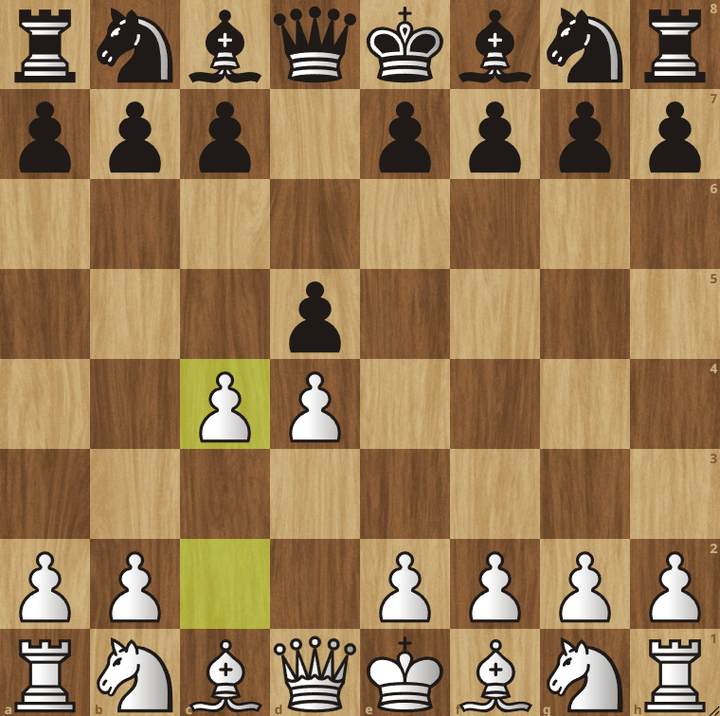
After 1.d4, there are 3 ways that Black can stop you from playing 2.e4 (which is what you want to play). But only two of them are seen at the top level. One of those ways is 1...d5 - this obviously stops you from playing 2.e4 (taking full control of the centre). The absolute best way to fight for an advantage after 1...d5 is to gambit your c-pawn iwth 2.c4. Not don't worry, you will always be able to recapture it if they take accept the gambit, but even if you couldn't - it's worth it. With 2.c4, you immediately put pressure on the centre, meaning that Black can't just play some random move like 2...a6 because then White could continue 3.cxd5 Qxd5 4.Nc3 followed by 5.e4... Black needs to either accept the gambit, or decline it by supporting the d-pawn with 2...c6 (Slav) or 2...e6 (Traditional). Note that 2...Nf6? allows White to gain a healthy advantage with 3.cxd5 Nxd5 4.e4, winning the centre. The Queen's Gambit is a highly studied and complex strategical opening which has a variety of ways of being played. It has been the most favoured opening at the highest level for most of history - and continues to be the 2nd most popular GM level opening only after the Sicilian Defence. So, if Black accepts the gambit with 2...dxc4 (Queens Gambit Accepted), White has two major options: 3.e3 and 3.e4. 3.e3 is a safe, flexible option which I would recommend for beginners as Black frequently tends to blunder very early after 3...b5? (as they notice the pawn is attacked by the bishop) 4.a4! c6 (because 4...a6 5.axb5 axb5 6.Rxa8) 5.axb5 cxb5 6.Qf3 (wins material). Instead, Black should let the pawn go with 3...Nf6. Otherwise 3.e4 immediately takes control of the centre, but leads to sharper lines, as 3...b5 is now playable, because at the end of that trap line I showed before, White will not have the Qf3 trick, as our pawn on e4 would block the queen's attack on the rook. So there's 3...b5 for starters, but White also needs to know what to do against the sharp 3...e5 - very interesting aggressive variations for boths sides. Now moving on to the two major declined lines. 2...e6 is the Traditional Queens Gambit Declined, which is an incredibly solid approach, not allowing White much attack at all, and weaving a deep positional web for the rest of the game. The Traditional Queen's Gambit Declined is one of the most solid openings in all of chess, and is perfect for someone more inclined for a safe, positional grind, inclined for an endgame. The minor drawback of the traditional QGD is that the bishops don't get active for a while at the start of the game - which is only a drawback from a style standpoint. Though, still, I would recommend that White play the exchange variation and find a way to play f3 followed by e4. The Slav QGD is with 2...c6, and it's a slightly more aggressive way of playing against the Queens Gambit, and can lead, if you want it to, to either very solid maneuvering lines, or incredibly tactical lines. When Black plays a combination of both c6 and e6, it's called a 'Semi-Slav' and this too is very flexible. It is very rich in both tactical and strategical possibilities - and a LOT of theory. For example, one of the most complicated positions in chess arrises from this opening: 1.d4 d5 2.c4 e6 3.Nc3 Nf6 4.Nf3 c6 5.Bg5 dxc4 6.e4 'Botvinnik Variation'.
Most played line on Lichess (<2000):
1.d4 d5 2.c4 dxc4 3.e4 e6?! 4.Bxc4 Nc6? 5.Nf3 Bb4+ 6.Nc3 Nf6 7.Bd3 Nxd4?? 8.Nxd4 (White is winning).
Most played Master line (2021-2023):
1.d4 d5 2.c4 c6 3.Nf3 Nf6 4.Nc3 e6 5.Bg5 h6 6.Bh4 dxc4 7.e4 g5 8.Bg3 (White is slightly better).
Section 3.1) 1.d4 Nf6 2.c4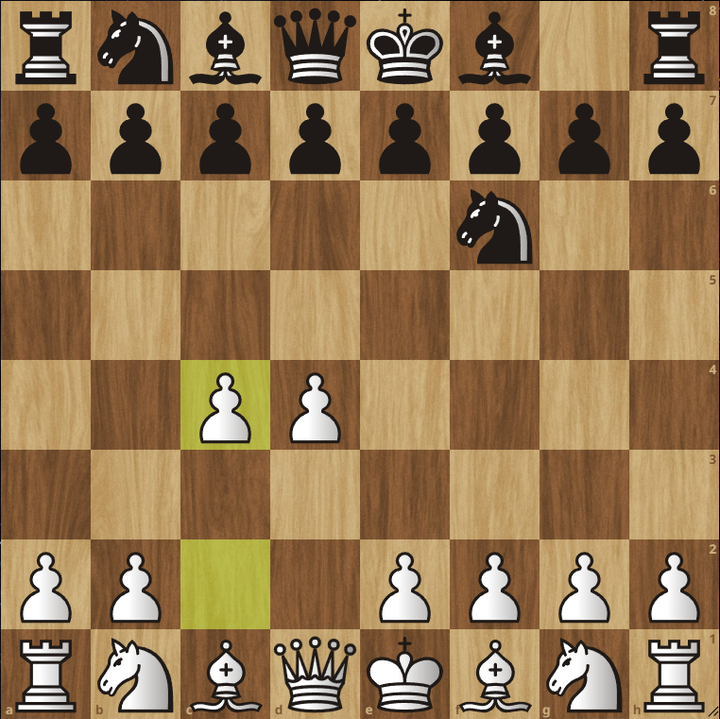
1...Nf6 is a more modern, indirect way of controlling the centre, and preventing White from playing e4. Black would love whenever possible, to play both Nf6 and d5, but like we saw in the 1...d5 lines, White should make this impossible with 2.c4. 2.c4 prevents 2...d5 (as we saw in the last subsection) because of 3.cxd5 Nxd5 4.e4. Instead, Black will use a number of different methods to counterattack after White inevitably controls is a little more of the centre than Black. White needs to be ready for a number of openings from here, each with unique attacking ideas, such as: the Nimzo-Indian (2...e6; where Black will attempt to play Bb4, O-O, d5, and c5 to attack the centre and annoy the c3-knight, potentially leaving White with doubled-pawns), the Kings Indian (2...g6 3...Bg7; where Black will lock up the centre, allowing White a slight space advantage and an easy attack on the queenside, but at the same time, allowing a huge unorthadox kingside attack for Black), the Benoni (2...c5 3...e6; where Black allows an immediate space advantage, but then counterattacks through a combination of breaking down the centre with a variety of pawn breaks, interesting piece maneouvers, and the typical kingside fianchetto), and the Grunfeld (2...g6 3...d5; where Black allows White to take full control of the centre, but in exchange gets very inetersting dynamic positions involving massive amounts of pressure on the c3 square, and lots of activity revolving around the queenside and fianchetto'd kingside bishop) to name a few. So 2.c4 is the best way to face 1...Nf6, and you White will always be ever so slightly better if you play all the best moves, but you'll need to learn a lot of theory (as is the case with most openings). This is basically the only move you see against 1...Nf6 at the highest level.
Most played line on Lichess (<2000):
1.d4 Nf6 2.c4 g6 3.Nc3 Bg7 4.e4 d6 5.Nf3 O-O 6.Be2 e5 7.O-O Nc6 8.d5 (White is slightly better).
Most played Master line (2021-2023):
1.d4 Nf6 2.c4 e6 3.Nf3 d5 4.Nc3 Bb4 5.Bg5 h6 6.Bxf6 Qxf6 7.e3 O-O 8.Rc1 (White is slightly better).
Section 3.2) 1.d4 2.Bf4 3.e3 4.Nf3 "London System"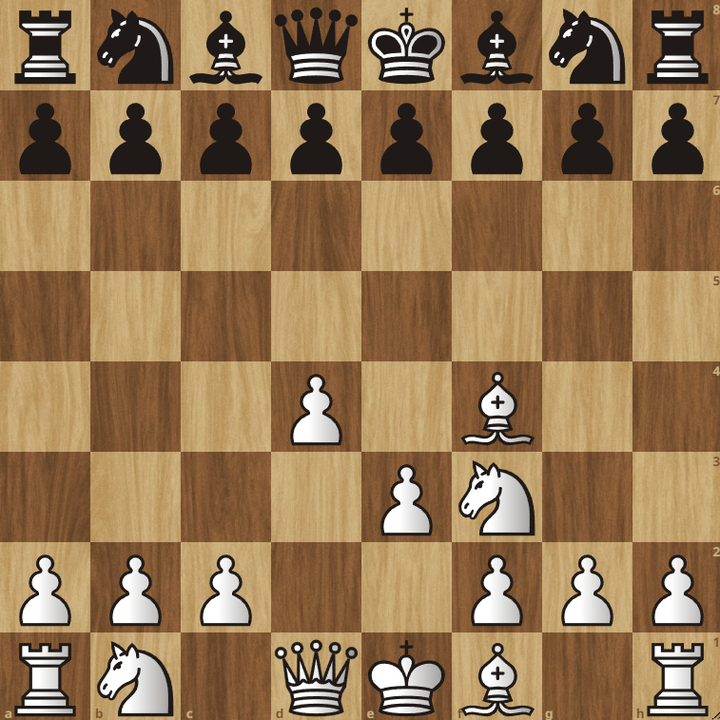
The London System is a 'system', meaning that you will play the same set up against basically anything that Black employs. White gives away their initial initiative, and hopes that their great positional set up will be enough to both stop Black's counterattack, and help slowly build up an attack, sometimes quite venomously on either side of the board depending on which way White castles. White's plan is to play 1.d4, followed by 2.Bf4, 3.e3 (to not lock out the c-bishop) and 4.Nf3. This setup (in the image above) is a very solid structure with nearly no weaknesses, and easy piece development. White's next moves will almost definitely be as follows (with varrying move order): 5.c3, 6.Bd3, 7.Nbd2 8.Qc2 and 9.O-O or O-O-O depending on how you want to play the middlegame. One thing to note in the London is that the b2 square is temporarily weak, and can be a target for Black early in the game. Thought once you play Qc2, those worries are usually alleviated. There is a lot less theory to memorise in this opening, and it's perfect for players who want to get the same sort of harmonious middlegame positions that they know how to navigate easily. It's a solid, reliable opening. It's seen now and again on the top level, recently, it was played in Game 6 of the Ding - Nepomniachtchi World Championship 2023, which White won.
Most played line on Lichess (<2000):
1.d4 d5 2.Bf4 Nc6 3.e3 Nf6 4.Nf3 e6 5.Nbd2 Bd6 6.Bg3 O-O 7.c3 Re8 8.Ne5 (White is slightly better).
Most played Master line (2021-2023):
1.d4 Nf6 2.Bf4 d5 3.e3 c5 4.c3 Nc6 5.Nd2! Bf5 6.Ngf3 e6 7.Qb3 Qc8 8.Nh4 (Equality).
Section 3.3) 1.d4 2.Nc3 3.Bf4 "Jobava London"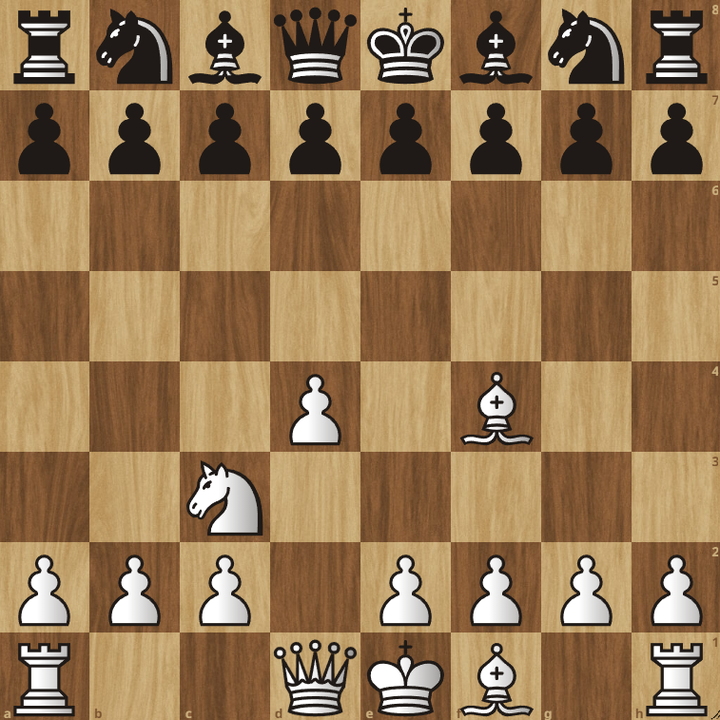
The Jobava London is an aggressive and imaginative version of the London, which injects a dynamic and tactical flavour into the otherwise solid opening. White plans to create interesting, unorthadox attacks which will catch Black off guard and force them to find precise moves to stay in the game. Two common ideas you see in the Jobava is to either use the piece coordination of the bishop and knight to attack c7 through Nb5-c7. But another idea it to play for f3, g4, h5, etc. with a kingside pawn storm. This opening has the solid nature of the London system with a very similiar pawn structure and piece configuration, while allowing for interesting, unique attacking ideas which are very likely to catch their opponents off guard. It's seen rarely on the top level, and is a fairly new opening in general.
Most played line on Lichess (<2000):
1.d4 d5 2.Nc3 Nf6 3.Bf4 e6 4.Nb5 Bd6?! 5.Nxd6+ cxd6 6.e3 O-O 7.Nf3 Nc6 8.c3 (White is slightly better).
Most played Master line (2021-2023):
1.d4 d5 2.Nc3 Nf6 3.Bf4 e6 4.Nb5 Na6 5.e3 Be7 6.Nf3 O-O 7.Be2 c6 8.Nf3 (Equality).
Section 3.4) 1.d4 2.c4 3.g3 "Catalan"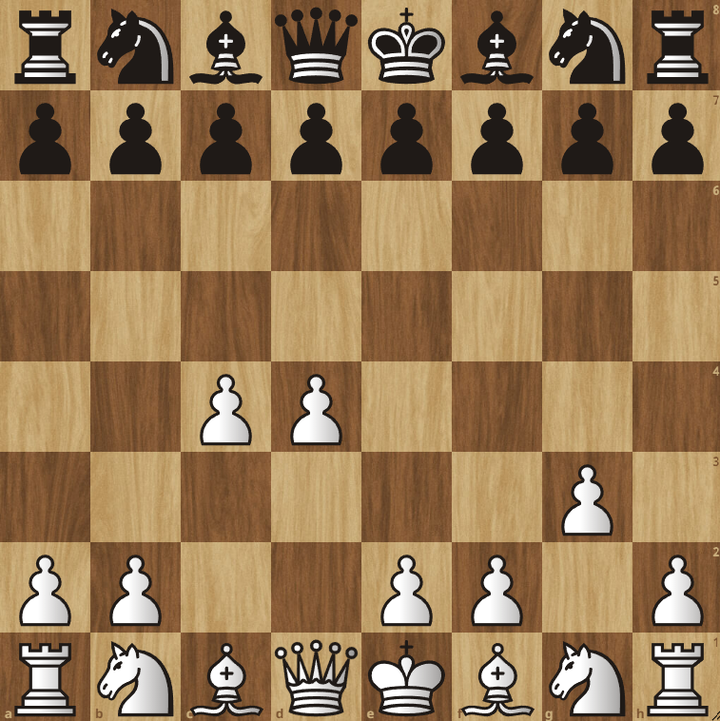
The Catalan is a system-like opening which can be employed against nearly every top level Black opening, but unlike the Londons and Trompowsky, it doesn't allow Black to play d5 (because of 2.c4). For this reason, it does not give up White's initial advantage, and is one of the most popular openings at the moment at the highest level, loved particularly by GMs including Magnus Carlsen, Daniil Dubov, Vladimir Kramnik, Ding Liren, Anish Giri & Boris Gelfand. The Catalan plans are fairly straightforward: First, attain the set up with: Bg2, Nf3, and O-O, then, depending on whether they capture the pawn on c4 or not (Open or Closed Catalan) will show you how to progress on the queenside, but the thematic moves include: Qc2, and then either Nbd2 and e4, or Nfd3, Nc3 and then e4. It's a suprisingly easy-to-play opening where you don't need to know a whole lot of theory to get a nice position, but obviously, like any opening, if you want a good chance at attaining any serious advantage then you need to learn quite a bit of theory. The positions that you recieve have lots of tactical chances for both sides, and both sides have long-term strategical plans.
Most played line on Lichess (<2000):
1.d4 d5 2.c4 e6 3.g3 Nf6 4.Bg2 c6 5.Nf3 Be7 6.O-O O-O 7.Qc2 Nbd7 8.Nbd2 (White is slightly better).
Most played Master line (2021-2023):
1.d4 Nf6 2.c4 e6 3.Nf3 d5 4.g3 Bb4+ 5.Bd2 Be7 6.Bg2 O-O 7.O-O c6 8.Qc2 (White is slightly better).
Section 3.5) 1.d4 Nf6 2.Bg5 "Trompowsky"
The Trompowsky Attack is an aggressive and unorthodox chess opening that starts with 1.d4 Nf6 2.Bg5. It aims to disrupt Black's development and create imbalances from an early stage. By challenging the knight on f6, White aims to divert Black's pieces and limit their options. The Trompowsky often leads to asymmetrical pawn structures and tactical possibilities, including Black's doubled pawns on f6 - which White's plans usually revolve around. White typically follows up with moves like Nc3, f2-f3, and e2-e4 to consolidate the center and launch an attack. It is a strategic choice for players seeking to surprise their opponents, introduce unfamiliar positions, and create a dynamic and aggressive game. It rarely gets played at the top level.
Most played line on Lichess (<2000):
1.d4 Nf6 2.Bg5 e6 3.e4 Be7?! 4.e5 Nd5 5.Bxe7 Qxe7?! 6.c4 Nb6?! 7.Bd3 d6 8.exd6 (White is better).
Most played Master line (2021-2023):
1.d4 Nf6 2.Bg5 d5 3.e3 c5 4.Bxf6 gxf6 5.dxc5 e6 6.Nf3 Bxc5 7.Be2 Nc6 8.O-O (Equality).
Section 4.0
Now as Black. You're going to want to prepare for the 2 most played openings. At every level, either 1.e4 or 1.d4 is played by White 88% of the time. Therefore, these are the two openings you should prepare for the most.
Let's take a look at some possible replies you can choose from against 1.e4, first.
We need to contest White from completing the golden rules, and in partiular, we need to stop them from dominating the centre. Now keep in mind, because White has the first move, they have the privilege to attack first. Black will almost always defend first, then counterattack. This explains why most White openings are called the "X Attack" and why most Black openings are called the "X Defence".
Anyway, here are a few options against 1.e4 that you can choose from:
Section 4.0) 1...e5 2.Nf3 Nc6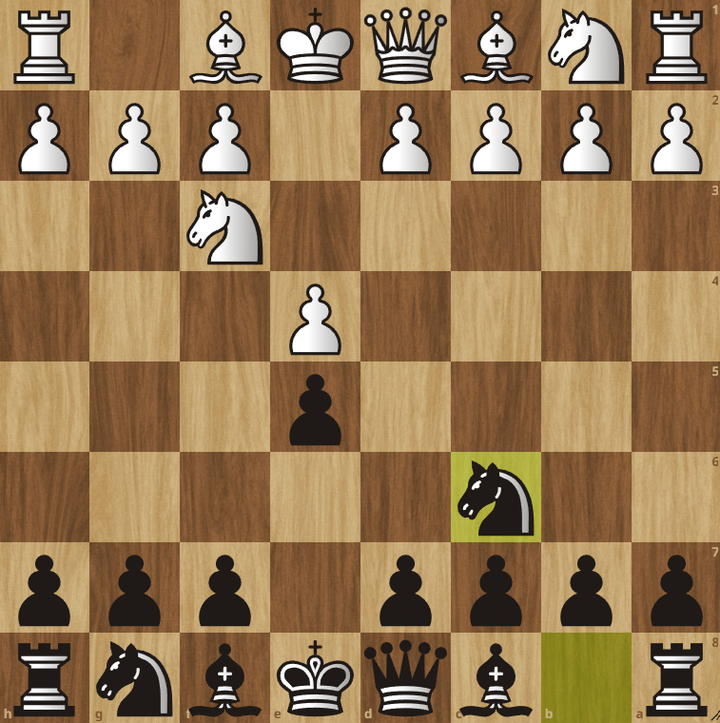
In my opinion, 1...e5 is the hardest opening to learn properly. You have to not only remember mountains of theory, but also, White can choose so many different openings, that you'll have to remember the specific different ideas against each of them. Though, 1...e5 is very likely the best move against 1.e4 - as it's symmetrical. Each an every opening White can employ, there is a sufficient defence/counterattack that Black can play to attempt to win. The trouble is remembering it all. With 1...e5, Black is saying they're ready for: Kings Gambit, Danish Gambit, Vienna, Scotch, Ponziani, Ruy Lopez, and Italian. The prospect of the theoretically complex kings gambit alone is enough to scare many off. But if you're brave enough, and have a high work ethic, this opening is for you - its very rich in opening choices of all kinds. Though if you want to play even more solid, then you can look at the next opening. This is the opening seen the most nowadays to face 1.e4, as the Najdorf is ever so slowly losing popularity (very recently - as openings go in and out of fashion to keep people on their toes). The point of the move, is that it's really the only good way to defend the e-pawn, as 2...d6 is immediately worse to 3.d4, and 2...f6? practically loses to 3.Nxe5!
Most played line on Lichess (<2000):
1.e4 e5 2.Nf3 Nc6 3.Bc4 Bc5 4.c3 Nf6 5.d4 exd4 6.cxd4 Bb4+ 7.Nxe4! O-O 8.Bxc3 (Black is better).
Most played Master line (2021-2023):
1.e4 e5 2.Nf3 Nc6 3.Bb5 a6 4.Ba4 Nf6 5.O-O Be7 6.Re1 b5 7.Bb3 O-O 8.c3 d5! (Equality).
Section 4.1) 1...e5 2.Nf3 Nf6 "Petrov"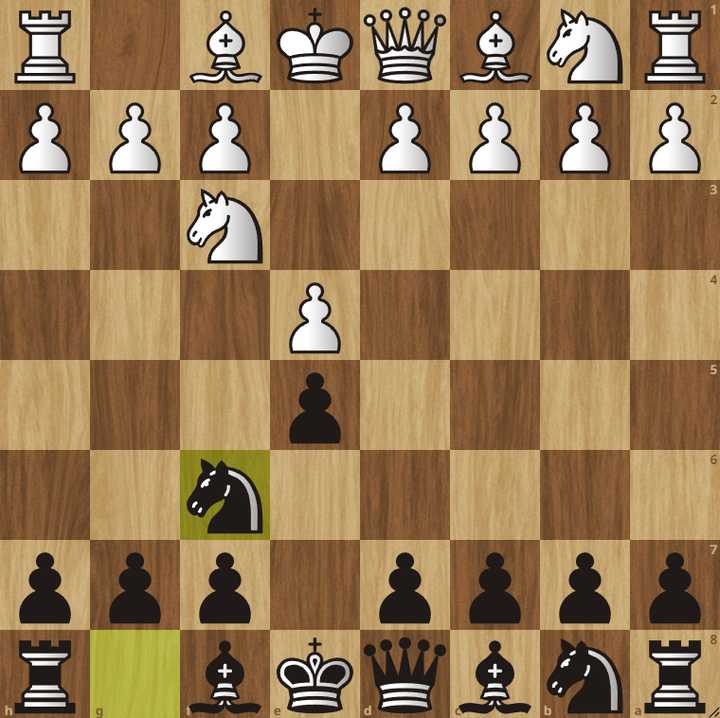
After 1...e5, risking some scary gambits, Black then diverts away from the popular Ruy Lopez and Italian, to receive a symmetrical, solid game with 2...Nf6. The Petrov has a very drawish reputation, but has recieved some attention after world champion candidate Fabiano Caruana used it extensively as Black with great results. The Petrov is much more about strategical maneuvering, putting a lot of emphasis on their understanding of the position, and how to play against the symettrical pawn structure - which White willl find very hard to play against since the position is so dry. 1.e4 players usually like creative open positions, and this is anything but - so the Petrov is a good weopon against a 1.e4 player psychologically, too. It is played now and then at the top level, and could very well be the engine's top move in the future as it is so symettrical.
Most played line on Lichess (<2000):
1.e4 e5 2.Nf3 Nf6 3.Nxe5 d6 4.Nf3 Nxe4 5.Qe2 Qe7 6.d3 Nf6 7.Qxe7+ Bxe7 8.Be2 O-O (Black is slightly better).
Most played Master line (2021-2023):
1.e4 e5 2.Nf3 Nf6 3.Nxe5 d6 4.Nf3 Nxe4 5.d4 d5 6.Bd3 Bd6 7.O-O O-O 8.c4 c6 (White is slightly better).
Section 4.2) 1...c5 2.Nf3 d6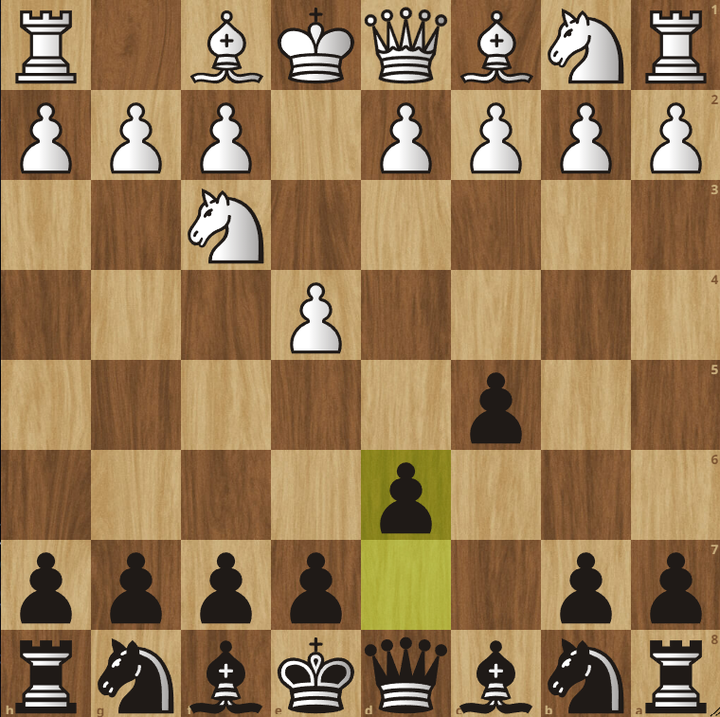
White's best and most common reply to the Sicilian Defence (1.e4 c5) is 2.Nf3. Because 2.d4 would likely lead to 2...cxd4 3.Qxd4 Nc6 (attacking the queen, which certainly isn't 'fighting for the initiative' as White). So after 2.Nf3, White prepares to play 3.d4 with more protection (from the knight). There are 3 main moves that Black can play here, which I mentioned previously in prior section; 2...d6, 2...Nc6 and 2...e6. This section elaborates on 2...d6. Black wants to play Nf6 and attempt to castle quickly - the issue is, it's bad to play 2...Nf6 immediately in view of 3.e5. So 2...d6 protects the e5 square, preparing to develop the knight to f6. Here, White almost always plays 3.d4 (justifying 2.Nf3). The whole reason Black has played 1...c5 is to take if White every plays d4 - so here we take with 3...cxd4. White takes back with the knight: 4.Nxd4 and here, Black plays 4...Nf6. Notice here that because of 2...d6, White cannot play 5.e5. Instead, they realise that 4...Nf6 hits the e-pawn, and they deffend it with 5.Nc3. This is where Black has even more opening options, which all have huge amounts of theory. The options are as follows: 5...Nc6 "Classical Variation" where Black favours the development of the queenside knight over the kingside bishop. Black therefore isn't in as much a rush to castle, and the lines are less sharp and direct. Instead, Black is playing solid, more flexible chess, there's still a lot of interesting theory, though. Another option is 5...g6 "Dragon Variation". This is one of the sharpest variations in chess in general. Black quickly develops the bishop to a terrific square and castles quickly, which counterattacks the queenside to fight White's kingside push with a queenside attack. The queenside attack is very tricky, and hard for White to stop, as Black not only has teh semi-open c-file for the rook, but also now the fianchetto'd g7 bishop. If Black learns perfect theory, they're very very hard to stop. Issue is, if both players stray away from theory (which usually happens), White's position/attack just plays itself - whereas Black's relies on engine defence which is very hard to work out (although objectively fine, and often winning). All in all, very strong, very hard to play. Then there is 5...a6 "Najdorf Variation". This can be seen as an advanced waiting move - waiting to see where White commits their pieces before deciding how to counterattack. In the Najdorf, a lot of the same ideas will come up from the Dragon, however Black will not fianchetto, and will delay castling in order to accelerate their queenside counter. They also frequently push e5, which temporarily creates a weakness on d5 (a key square for the opening), and Black often attempts to safely play d5 themselves. The game gets played on both sides of the board, as well as the centre, and as such, very imbalanced, dynamic positions come up with fireworks on the board. This is one of the most studied openings, and has some of the most theory of any opening. However, the positions aren't as sharp as the Dragon positions, and both sides are quite equal in the ease of their ideas. Many GMs say "I've been playing the Najdorf my whole life, I still have no idea what's going on". They're exaggerating of course, but it's worth keeping in mind - very fun to play, objectively the best move, and a lifetime of confusion. The amount of theory required, even just from move 6 is ungodly... Lastly, there is 5...e6 "Scheveningen Variation", which is less seen at the highest level because of new advancements in theory with new enginges. Nowadays, deep theoretical knowledge shows that 6.g4 "Keres Attack" gives a decent advantage for White - but only if they know deep ammounts of theory - which GMs do. Regardless, the Scheveningen is a very flexible opening with a 'small centre' (little to no weaknessess, more solid, and temporarily less ambitious), which can be transposed from a variety of move orders. It focusses on rapid development and a flexxible pawn structure, and was a favourite of former world champion Garry Kasparov throughout his career and youth.
Most played line on Lichess (<2000):
1.e4 c5 2.Nf3 d6 3.d4 cxd4 4.Nxd4 Nf6 5.Nc3 a6 6.Bg5 e6 7.f4 Be7 8.Qf3 Qc7 (White is slightly better).
Most played Master line (2021-2023):
1.e4 c5 2.Nf3 d6 3.d4 cxd4 4.Nxd4 Nf6 5.Nc3 a6 6.Be3 e5 7.Nb3 Be6 8.f3 h5 (Equality).
Section 4.3) 1...c5 2.Nf3 Nc6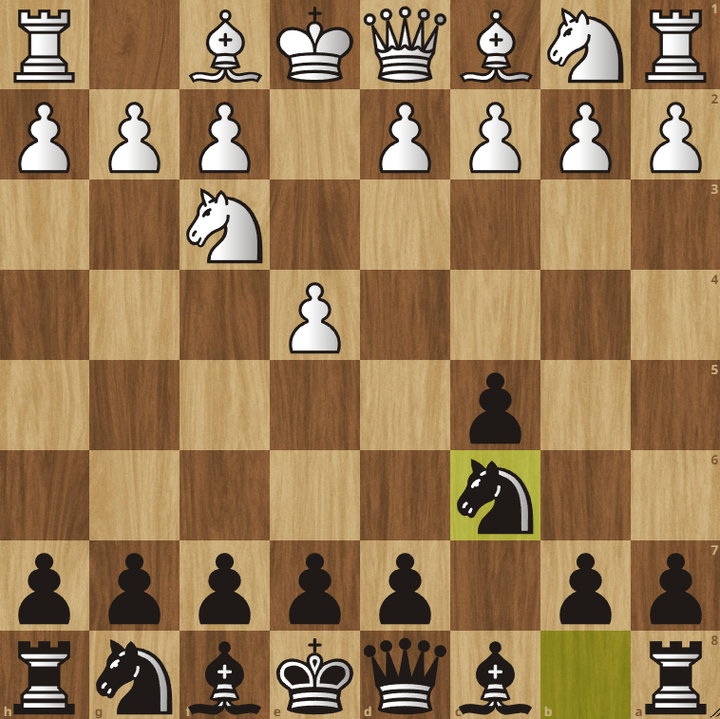
Continuing on, 2...Nc6 is the other way to stop an eventual e5, preparing Nf6. Once again, usually, White plays 3.d4 - we take: 3...cxd4 4.Nxd4 and now, we do not play 4...Nxd4, because after 5.Qxd4, the queen would be strong in the centre with no competition or threats against her. So instead, we play 4...Nf6, hitting the e-pawn. White should never take on c6, because if 5.Nxc6?!, then bxc6, and Black will be the one taking over the centre as they have three pawns aimed at the centre (d5 is coming), whereas White has one. As mentioned, a huge point of the Sicilian is that as Black you have more potential to take over the centre with both central pawns, whereas White only has one. The big issue is, because you have no c-pawn, whenever you play e5, you create a hole on d5 (which becomes the crucial square for the whole game). So, White instead willl play 5.Nc3 (defending the pawn), and here Black will play 6...e5 "Sveshnikov Variation". The point of this opening is that Black ends up giving up the d5 square, but in exchange, they will almost certainly get: queenside space, the bishop pair, and great chances at taking over the centre with a timely f5 break - but, it's sometimes hard to tell when is the right time to play f5, and it is hard to play around White's knight on d5. This opening is the favourite of former world champion GM Magnus Carlsen, and it's played regularly at the top level. Another option on move 4, is to play 4...g6 "Accelerated Dragon", which is a more classical version of the dragon which is still very tricky, but less sharp, and less aggressive. It's a really great suprise weapon, but there's one issue - because Black hasn't forced White to play Nc3 (to defend the e-pawn thereby blocking the c-pawn), White can play the "Maroczy Bind" with 5.c4, before playing Nc3, taking over more of the centre. Note that inserting 4...Nf6 first to entice White to play 5.Nc3, then 5...g6 isn't possible because of 6.Nxc6! bxc6 7.e5. The Accelerated Dragon can be hard to play against if White fully understands what they're doing, and as a result, this opening is virtually never seen at the top level. Regardless, it's still a terrific choice at the under GM level - very tricky both tactically and positionally. Finally, a small note on the fact that after 2...Nc6, White has one other major option they may employ: The "Rossolimo" with 3.Bb5. It's a well respected alternative line which aims to double Black's pawns with Bxc6. The game is all about positional struggles in complex dynamic positions. It was popularised recently by GM Fabiano Caruana in his world championship against GM Magnus Carlsen. Black's major responses are 3...g6 and 3...e6.
Most played line on Lichess (<2000):
1.e4 c5 2.Nf3 Nc6 3.d4 cxd4 4.Nxd4 g6 5.Nc3 Bg7 6.Be3 Nf6 7.f3 O-O 8.Qd2 d5 (Black is slightly better).
Most played Master line (2021-2023):
1.e4 c5 2.Nf3 Nc6 3.d4 cxd4 4.Nxd4 Nf6 5.Nc3 e5 6.Ndb5 d6 7.Bg5 a6 8.Na3 b5 (White is slightly better).
Section 4.4) 1...c5 2.Nf3 e6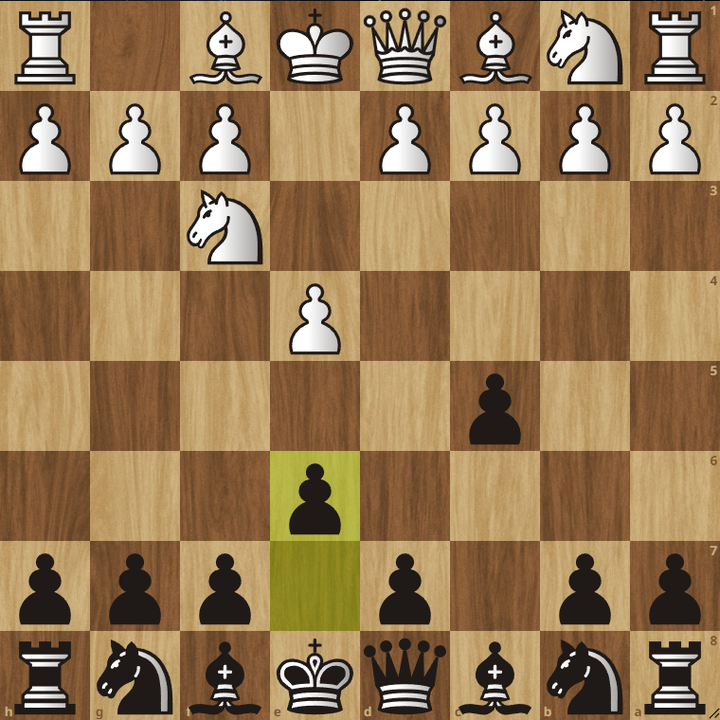
The final deviation here, is 2...e6. With this move, Black attempts to quickly develop their pieces to natural squares, but in doing so, because of the nature of the arrising positions, hugely interesting imbalances are created that allow for brilliantly complex tactical and stratefigal complications. After 3.d4 cxd4 4.Nxd4, there are two main moves, 4...a6 "Kan Variation" and 4...Nc6 "Taimanov Variation". The Kan is another flexible option, which is less solid than the Taimanov, and can reach complicated, uncomfortably sharp positions for both sides. Black usually plays moves like Qc7, b5, Bb7 etc. And White can attempt to advance with the kingside attack. It's a pretty easy-to-play opening that has lots of strategical tricks, but Black will often have to face a Maroczy Bind with 5.c4 which can be annoying. Then there is the Taimanov, which as mentioned, is a little more solid version of the Kan. A lot of the same plans are going to be employed, and it's a great opening for those that like playing createively on both sides of the board. In both of these openings, lots more pressure will be placed on teh c3 square, because of the insertion of Bb4 and Qc7, potentially helping in a queenside attack.
Most played line on Lichess (<2000):
1.e4 c5 2.Nf3 e6 3.d4 cxd4 4.Nxd4 Nc6 5.Nc3 Qc7 6.Be3 a6 7.Qd2 Nf6 8.f3 Be7 (White is slightly better).
Most played Master line (2021-2023):
1.e4 c5 2.Nf3 e6 3.d4 cxd4 4.Nxd4 Nc6 5.Nc3 Qc7 6.Be3 a6 7.Qf3 Nf6 8.O-O-O Ne5 (White is slightly better).
Section 4.5) 1...e6 "French"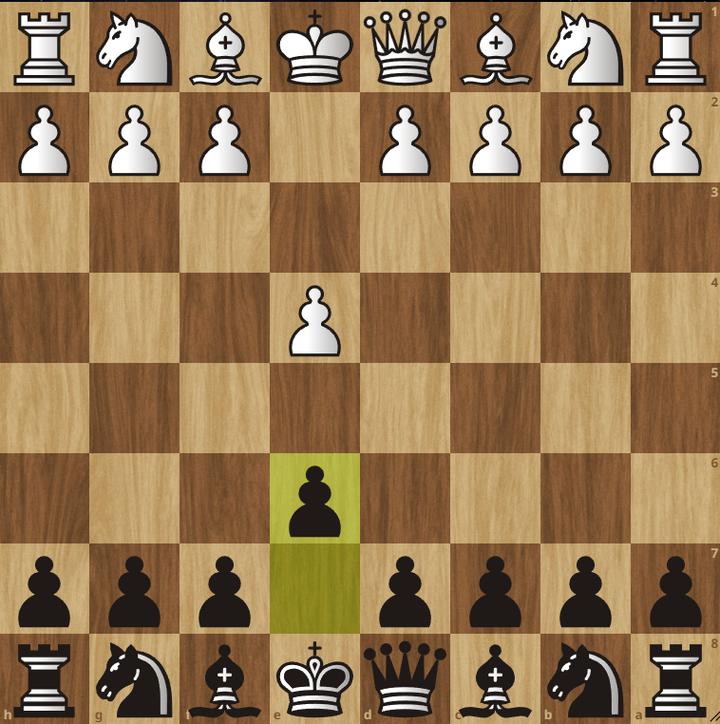
The French is an opening that allows White to set up their pawns in the centre before counterattacking the centre, and attempting to break it down. Openings like this are a different way of fighting for the centre, where if Black is successful in their counterattack throughout the game, they're going to hold it for the rest of the game, but if not, they're going to struggle all game to no avail. In the French, Black's main counterattacking move is c5. The opening typically goes: 1.e4 e6 2.d4 d5, at which point White has 3 major branches: 3.Nc3 - which has 3 branches that Black can choose from: 3...dxe4 "Rubinstein" (Flexible, Principled, Open), 3...Bb4 "Winawer" (Dynamic, Sharp, Wild), and 3...Nf6 "Classical" (Positional, Tactical, Dynamic). Another major branch for White is 3.e5 "Advance Variation" where White attempts to lock up Black's kingside development, as well as keep Black's light squared bishop trapped behind their pawn chain. However, Black will immediately attempt to break free with 3...c5, which forces 3.c3 (otherwise Black will easily undermine White's centre). The thematic c5 break is easy to play, and hard to stop - it needs to be taken very seriously as it is a very long-term strategical struggle. The final branch for White on move 3 is 3.exd5 "Exchange Variation", which will probably lead to very drawn symmetrical positions which are perfect for those drawn to endgame grinds.
Most played line on Lichess (<2000):
1.e4 e6 2.d4 d5 3.e5 c5 4.c3 Nc6 5.Nf3 Bd7 6.Bd3 cxd4 7.cxd4 Qb6 8.O-O Nxd4 (Black is slightly better).
Most played Master line (2021-2023):
1.e4 e6 2.d4 d5 3.e5 c5 4.c3 Nc6 5.Nf3 Bd7 6.Be2 Nge7 7.O-O Ng6 8.g3 Be7 (White is slightly better).
Section 4.6) 1...c6 "Caro-Kann"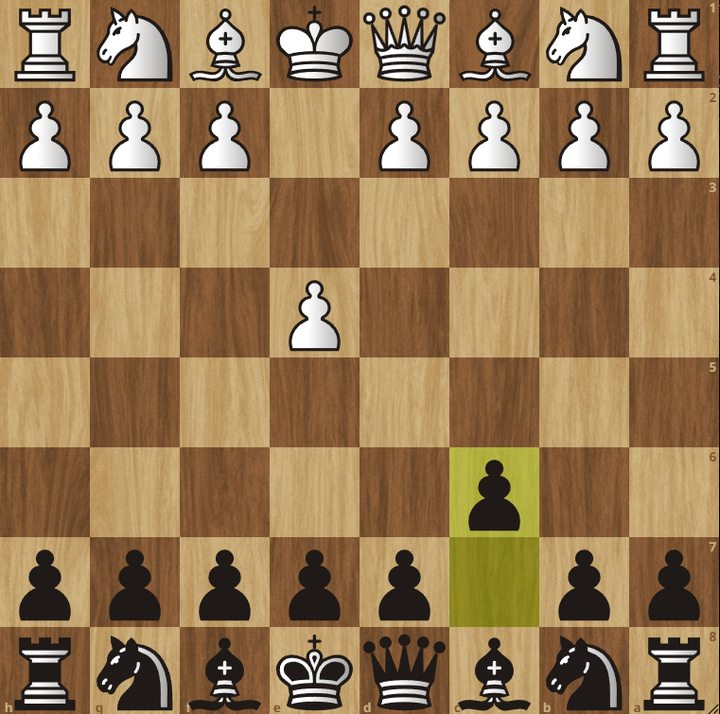
The Caro-Kann is a similar opening to the French, because you allow White to take the centre, and then you attempt to counterattack the centre with d5 and eventually, c5. The major differences is that in the Caro-Kann, you don't get your bishop trapped in, but in exchange, your c5 break comes a little later, and isn't as aggressive. The Caro-Kann is much more conerened about an endgame with a superior pawn structure. It's a solid, easy to play opening that garuntees a nice endgame if you're into that. One downside is that it's not all that intuitive, meaning that you'll need to learn some long-term ideas to even develop your kingside properly and castle. White's replies are actually the same as in the French (with a couple of extras): 3.Nc3 "Classical", 3.exd5 "Exchange", and by far the most popular 3.e5 "Advance". If 3.Nc3, then Black can play 3...dxe4 4.Nxe4 and 4...Nf6, 4...Nd7, or 4...Bf5. If 3.exd5, then Black can play 3...cxd5 and Black has gotten a symmetrical position, however, Black has both centre pawns still. And if 3.e5, then Black has two options: the well known 3...Bf5, or the off-beat 3...c5. With 3...c5, Black sidesteps a lot of theory, and immediately challenges the centre which reaches interesting imbalanced positions. If instead, Black chooses to play 3...Bf5, then they need to be prepared for a few moves: 4.h4, 4.g4, 4.Nf3, 4.Nd2 and 4.c4. If you do your research you won't really face any issues and get a great endgame. Despite it's closed reputation, it's actually a very fighting opening. A favourite of former world champion GM Anatoly Karpov, and current favourite of GM Alireza Firzouja (Probably a future world champion). It's played fairly frequently and the top level.
Most played line on Lichess (<2000):
1.e4 c6 2.d4 d5 3.e5 Bf5 4.Nf3 e6 5.Bd3 Bxd3 6.Qxd3 c5 7.c3 Ne7 8.O-O Nf5 (Equality).
Most played Master line (2021-2023):
1.e4 c6 2.d4 d5 3.e5 Bf5 4.Nf3 e6 5.Be2 c5 6.Be3 cxd4 7.Nxd4 Ne7 8.O-O Nbc6 (White is slightly better).
Section 4.7) 1...d5 "Scandinavian"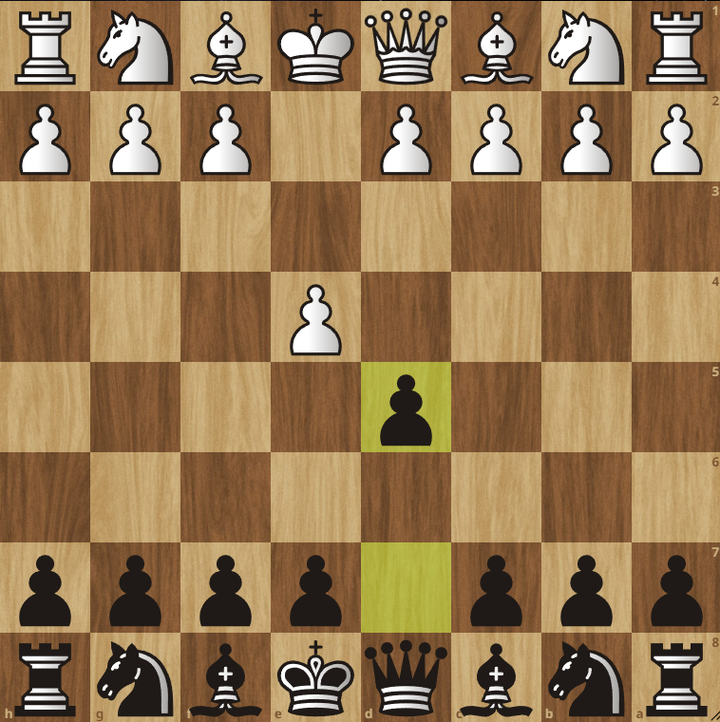
The Scandinavian is a very combative opening which attempts to disrupt White's control of the centre (by challenging the e-pawn). It often leads to very fresh positions where Black castles queenside and attacks on the kingside. It has a tendancy to lead to new positions where both sides can play without the burden of mountains of theory. It's a perfectly sound opening, despite it's initial 'look'. I do not recommend this at all to beginners, because they have a tendancy to lose their queen after bringing it out early, but if you're already a decent player and you're prepared for learning the ideas behind the opening, then go for it. After 1...d5, White must capture with 2.exd5, then after 2...Qxd5, Black's queen is in the centre, and will be attacked, which gives White free development: 3.Nc3. Here there are 3 options of where you want to put your queen, but they all lead to similar positions: 3...Qd8 - the safest for your queen, 3...Qd6 - the most unorthadox, but slightly more aggressive, and 3...Qa5, the most principled, and a balance of safety and attack. Let's say after 3...Qa5, White plays 4.d4, Black plays 4...Nf6 5.Nf3 Bf5, and whenever White plays the eventual 6.Bd2 (preparing a discovery on Black's queen), we play 6...c6 (givng our queen the c7 square). Then Black has easily development on either side of the board, usually with Nbd7, O-O-O and then a timely g5. It can feel hard to play, because at the start, it's so easy and good-looking for White, but the opening does have merit - but again, stay away if you're a beginner. It is played rarely at the top level, but often by former world champion GM Magnus Carlsen.
Most played line on Lichess (<2000):
1.e4 d5 2.exd5 Qxd5 3.Nc3 Qa5 4.d4 Nf6 5.Nf3 Bf5 6.Bd2 c6 7.Ne4 Qc7 8.Nxf6+ exf6 (White is slightly better).
Most played Master line (2021-2023):
1.e4 d5 2.exd5 Qxd5 3.Nc3 Qa5 4.d4 Nf6 5.Nf3 Bf5 6.Ne5 c6 7.Bc4 e6 8.g4 Bg6 (White is slightly better).
Section 4.8) 1...d6 "Pirc"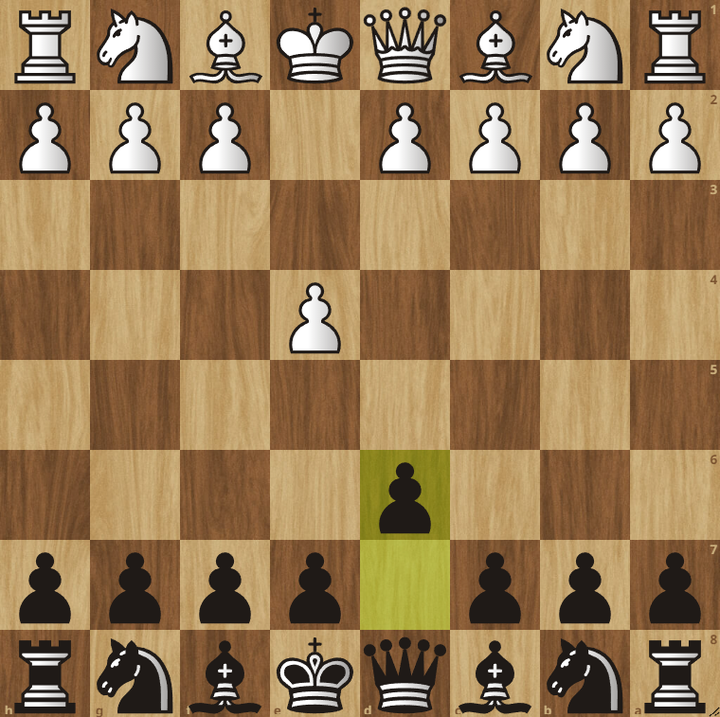
The Pirc is a 'system defence' where Black will likely play the same setup regardless of what White plays. It's very similar to the Kings Indian Defence, except White usually takes the oppertunity to quickly play Nc3 instead of c4 (though if White chooses, they can transpose). Black starts with 1..d6 so that after 2...Nf6 White doesn't have e4-e5. The setup is as follows: 1...d6, 2...Nf6, 3...Bg7, 4...O-O. White almost always plays e4, d4, Nf3, and Nc3, though sometimes may insert f4 before Nf3 (Austrian Attack). Black's plan is to counterattack the centre with e5 and or c5 so that their pieces open up harmoniously throughout the game (especially the g7-bishop). Though, if Black would like, they can play an early 3...e5 followed by 4...Nbd7 which would tranpose into an opening called the "Lion Philidor", or "Black Lion", which is a little more direct and tricky in their counterattacking prospect. The counterattacking ideas of this alternative are likely to catch White off guard, who were expecting the solid and less tricky Pirc. This opening is very rarely seen at the highest level. But because it's not played as much, it can be a great suprise weapon for any level.
Most played line on Lichess (<2000):
1.e4 d6 2.d4 Nf6 3.Nc3 g6 4.Be3 Bg7 5.Qd2 c6 6.Bh6 Bxh6 7.Qxh6 Qa5 8.Bd3 c5 (White is slightly better).
Most played Master line (2021-2023):
1.e4 d6 2.d4 Nf6 3.Nc3 g6 4.Nf3 Bg7 5.Bc4 O-O 6.O-O Nxe4! 7.Nxe4 d5 8.Bxd5 Qxd5 (Black is slightly better).
Section 4.9) 1...Nf6 "Alekhine"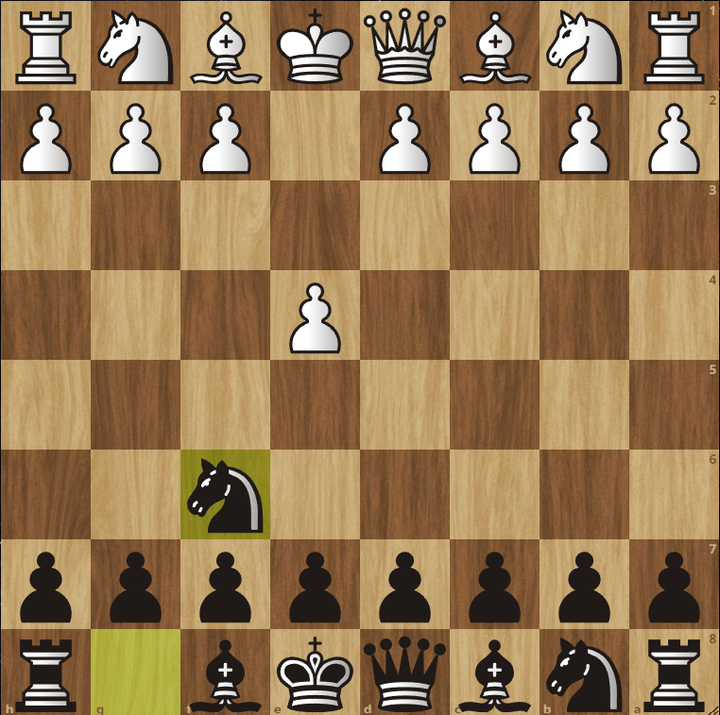
This is another opening I would not recommend at the lower levels. It is a very provocative opening where Black attacks the e-pawn immediately, disrupting White's opening development, and almost forcing White to march forward with the very natural and strong 2.e5. So after 1.e4 Nf6 2.e5 Nd5 3.d4, Black has completely given up the centre, however, Black will attempt to argue that White has overextended the centre, thereby weaknening their central pawns. Black will play 3...d6 immediately challenging the centre, hoping that White captures the pawn, leaving them with a very fragile centre. Instead White is very likely t play either 4.Nf3 - after which Black has numerous plans and options including 4...g6, 4...dxe5, and 4...Bg4. or 4.c4, where Black will play 4...Nb6, and White can choose again between two options, the aggressive 5.f4 "Four Pawns Attack", which Black has the style to usually invite happily, or 5.dxe5, which gives White rapid development, but Black the two central pawns and therefore long-term chances to take over the centre. The Alekhine is again, very rarely seen at top level play, and it's hard to play for beginners, but if you're a fairly advanced player, it can be a very powerful surprise weapon that I doubt White knows much about.
Most played line on Lichess (<2000):
1.e4 Nf6 2.e5 Nd5 3.d4 d6 4.c4 Nb6 5.exd6 cxd6 6.Nc3 g6 7.Be3 Bg7 8.Rc1 O-O (White is slightly better).
Most played Master line (2021-2023):
1.e4 Nf6 2.e5 Nd5 3.d4 d6 4.Nf3 dxe5 5.Nxe5 c6 6.Be2 Bf5 7.O-O Nd7 8.Nf3 e6 (White is slightly better).
Now, to complete your repertoire, you'll need to select an opening against 1.d4. Here are some options:
Section 5.0) 1...d5 2.c4 e6 "Queens Gambit Declined"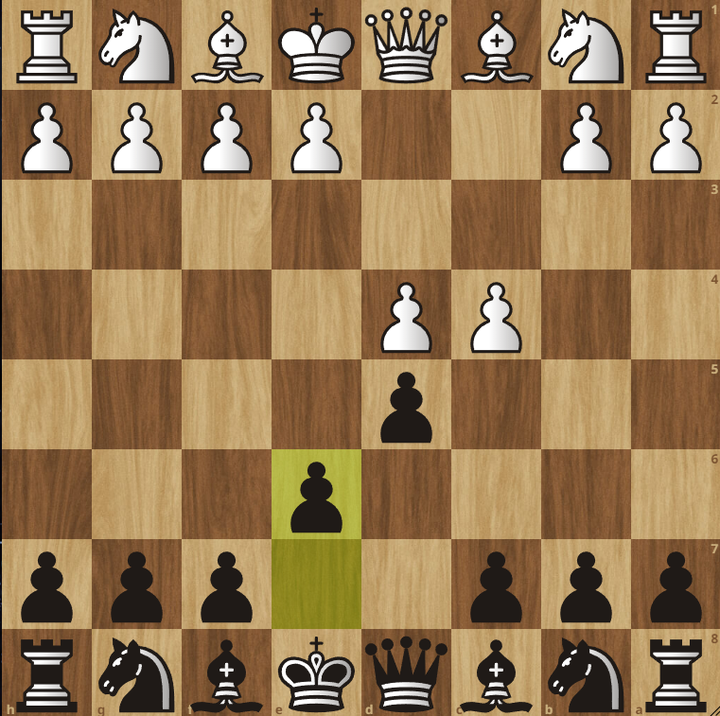
The Queens Gambit is a powerful and positional opening that White can immediately challenge Black with, and it's important that if you play 1...d5, you have an answer to it. After 1.d4, you have two major options as Black to stop White from playing 2.e4: 1...d5 - challenging the centre directly with a pawn, or the more modern 1...Nf6 - challening it with a piece, and in most cases, allowing White to take the centre completely, and only then counterattacking (usually with e5, c5, or d6). 1...f5 is another way to stop 2.e4, and we will get to that in due time, but it's not a way I recommend you play if you're just starting your chess career. Black would love to play both d5 and Nf6, however, after 1.d4 d5 2.c4 if Black plays 2...Nf6, White will play 3.cxd5 and after 3...Nxd5 4.e4 (Gaining the centre with tempo). Anyway, after 1.d4 d5 2.c4, there are 3 main ways to fight against the queens gambit. The easiest of the three, is to play 2...e6, the "Traditional Queens Gambit Declined" (QGD). This is the most solid option, which has literally hundreds of years worth of games, and so many strategical plans and possibilities. It temporarily blocks in the light-squared bishop, but leaves White with a positional struggle, and no attack. It's one of the most solid openings in chess, and a great choice for all levels. It's seen fairly frequently at the top level, and in the 1927 World Championship match between Caplanca and Alekhine, it was played in 32 of the 34 games.
Most played line on Lichess (<2000):
1.d4 d5 2.c4 e6 3.Nc3 Nf6 4.Bf5 Be7 5.e3 O-O 6.Nf3 h6 7.Bh4 b6 8.cxd5 Nxd5 (Equality).
Most played Master line (2021-2023):
1.d4 d5 2.c4 e6 3.Nc3 Nf6 4.cxd5 exd5 5.Bg5 c6 6.e3 Be7 7.Bd3 Nbd7 8.Qc2 (Equality).
Section 5.1) 1...d5 2.c4 c6 "Slav"
The Slav with 2...c6 is the other way good way to decline the queens gambit. It temporarily blocks the queens knight's ideal square, and allows strategically and tactically sharp positions to occur, often with Black heavily booked up. The Slav is a slightly more aggressive way of playing against the Queens Gambit, and can lead, if you want it to, to either very solid maneuvering lines, or incredibly tactical lines. When Black plays a combination of both c6 and e6, it's called a 'Semi-Slav' and this too is very flexible. It is very rich in both tactical and strategical possibilities - and a LOT of theory. For example, one of the most complicated positions in chess arrises from this opening: 1.d4 d5 2.c4 e6 3.Nc3 Nf6 4.Nf3 c6 5.Bg5 dxc4 6.e4 'Botvinnik Variation'. Both the Slav and Semi-Slav are seen at the top level fairly frequently.
Most played line on Lichess (<2000):
1.d4 d5 2.c4 c6 3.Nf3 Nf6 4.Nc3 e6 5.Bg5 h6 6.Bh4 dxc4 7.e4 g5 8.Bg3 b5 (Equality).
Most played Master line (2021-2023):
1.d4 d5 2.c4 c6 3.Nf3 Nf6 4.Nc3 e6 5.Bg5 h6 6.Bh4 dxc4 7.e4 g5 8.Bg3 b5 (Equality).
Section 5.2) 1...d5 2.c4 dxc4 "Queens Gambit Accepted"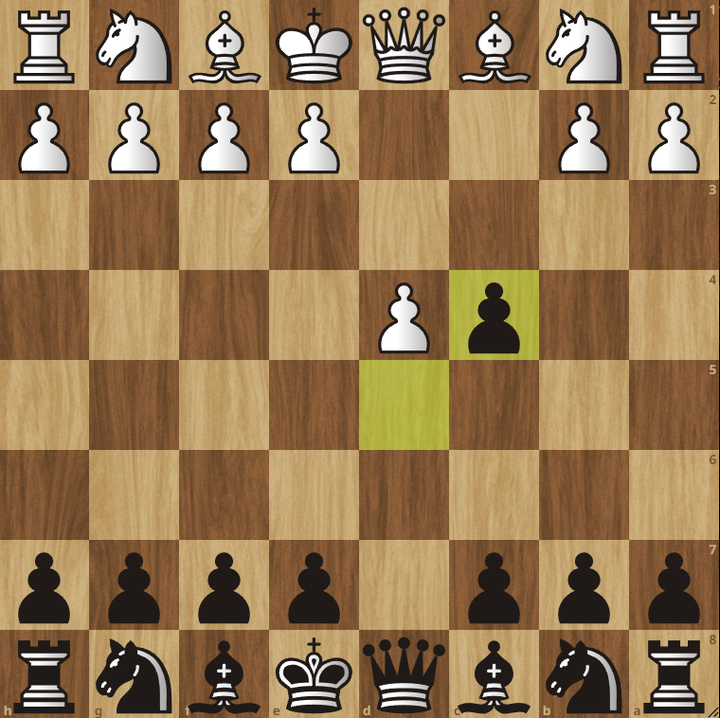
For a very long time, it was thought that accepting the Queens Gambit was thought to be quite dubious and a little unplayable - but in recent chess history, it's been seen as a bit of a drawing weapon. Accepting the gambit is completely fine if you're ready to return the pawn. It's only when Black attempts to hold on to the pawn do things go wrong. As Black's 2...dxc4 surrenders the centre, White will try to seize space in the centre and use it to launch an attack on Black's position. Black's game is not devoid of counterchances, however. If the white centre can be held at bay, Black will try to weaken White's centre pawns to gain an advantage in the ensuing endgame by playing c5 and cxd4 at some stage. If White responds with exd4, the result will be an isolated pawn on d4 – which can also lead to a keen middlegame battle. If White recaptures with a piece at d4 instead, the centre will be liquidated and a fairly even game will usually ensue.
Most played line on Lichess (<2000):
1.d4 d5 2.c4 dxc4 3.Nc3 a6 4.a4 e5! 5.d5 Bb4 6.e4 Qh4 7.Qc2 Nf6 8.Nf3 Qxe4+ (Black is winning).
Most played Master line (2021-2023):
1.d4 d5 2.c4 dxc4 3.Nf3 Nf6 4.e3 e6 5.Bxc4 c5 6.O-O a6 7.dxc5 Bxc5 8.Qxd8+ Kxd8 (Equality).
Section 5.3) 1...Nf6 2.c4 e6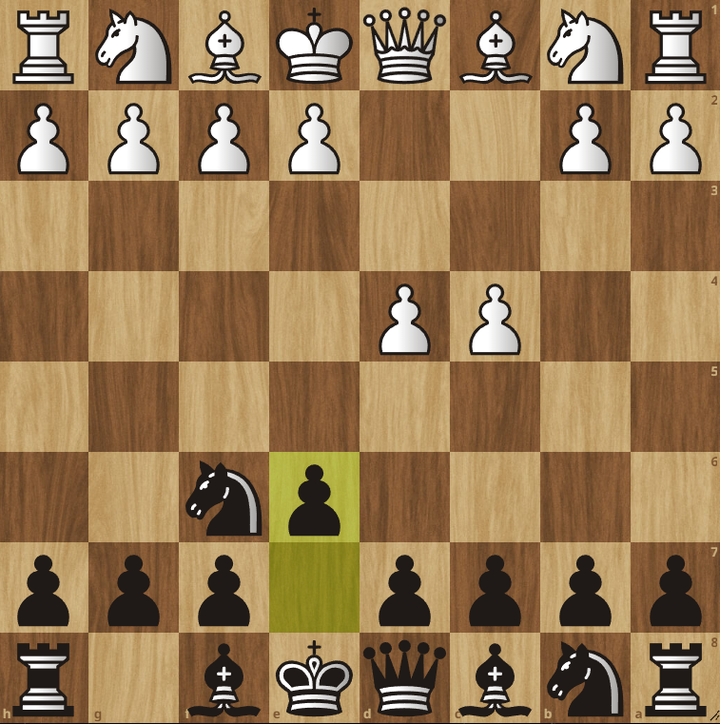
The other way to play against 1.d4 is with 1...Nf6 (Stopping 2.e4). Here, White will most likely play 2.c4 (Stopping 2...d5), and so, Black must make a choice of how they want to continue the game, whether to play 2...e6, 2...g6, or 2...c5. In this section we will look at 2...e6. The idea is simple, develop the bishop through the f8-a3 diagonal (usually to b4) and castle. Here, White has 2 main moves: 3.Nc3 and 3.Nf3. If 3.Nc3, then it's clear that White wantst to play 4.e4 with protection, so we stop them with the natural pin: 3...Bb4 "Nimzo-Indian Defence". Now 4.e4 isn't possible (because of 4...Nxe4). And so, White sets up in a number of ways, but Black's plans are usually the same: If provoked, play Bxc3 and play against the doubled c-pawns and isolated a-pawn. Then play O-O and c5, followed by some combination of c5, b6, and Ba6 or Bb7 depending on the position. Qa5 and Ne4 can also be common ideas to put extra pressure on c3. The Nimzo-Indian is played the most against 1.d4 at the highest level, and is also the easiest to play at every level. It grants Black a nice position throughout the whole game, but it's not guite as aggressive as other options.. Otherwise, if White plays 3.Nf3, then Black has two main options, to play 3...Bb4 anyway - the "Bogo-Indian Defence", or to play 3...b6 - the "Queens Indian Defence". Though, if Black wants, they can also transpose into a QGD with 3...d5. In the Bogo-Indian, Black hopes to either transpose into the Nimzo, or to get an easy to play, flexible position that White probably won't know all that much about. However, without the c3 pin, and chances to play against doubled pawns, it's a little more drawish and will rely on good endgame technique and creativity to score wins with. It's very rarely played at the top level, though. The Queens Indian is a little more fighting, as Black plays an early b6 with plans to develop the bishop either to b7 or a6, depending on what White plays. This opening didn't seem to lead to much in the early 2000s, and as such, has stopped being played much at the top level, but I have a feeling it will get back in fashion very soon, as there's nothing overly unambitious about it, and rather, there are some deep strategical ideas which may have become forgotten over the years.
Most played line on Lichess (<2000):
1.d4 Nf6 2.c4 e6 3.Nc3 Bb4 4.Qc2 O-O 5.a3 Bxc3+ 6.Qxc3 b6 7.Bg5 Bb7 8.e3 d6 (Equality).
Most played Master line (2021-2023):
1.d4 Nf6 2.c4 e6 3.Nc3 Bb4 4.e3 O-O 5.Bd3 d5 6.Nf3 dxc4 7.Bxc4 c5 8.O-O cxd4 (Equality).
Section 5.4) 1...Nf6 2.c4 g6 3.Nc3 d5 "Grünfeld"
The other way to develop the dark-squared bishop after 1.d4 Nf6 2.c4 is by fianchetto'ing it on g7, by playing the move 2...g6. On g7, the bishop acts not only as a defensive piece protecting the weak squares on h6 and f6, but also has a very attacking role, scoping down the entire a1-h8 diagonal. After 2...g6, White's main move at every level by far is 3.Nc3 (preparing 4.e4). This is where Black has two major options: To play an immediate d5, or to play Bg7 and d6. This section covers the immediate, 3...d5 "Grünfeld Defence". As we saw in previous sections, when White plays 1.d4 2.c4, Black cannot play Nf6 and d5 together without losing the centre with tempo. However here, because Black has already prepared to develop the bishop to g7, and because there is a white knight on c3, Black can set up a highly interesting and aggressive set up. The opening would then continue: 4.cxd5 Nxd5 5.e4 and now 5...Nxc3 is possible. And after 6.bxc3, White has massive control of the centre, but there are some weaknesses which Black can target: the weak backward pawn on c3, the isolated pawn on a2, the weak long diagonal which Black can control with Bg7, and the fact White hasn't castled. But in chess, a solid centre means a lot, so because defence nowadays is so good, the strength of the centre just cancels out those weaknesses, and the position is equal. So, Black continues with 6...Bg7 and White usually plays 7.Nf3. This is where Black's crucial break must be played: 7...c5. Of course, White cannot take due to Bxc3+ (picking up the rook), so White needs to be very careful while also attempting to castle into safety. Many ameteurs lose the position within the first 15 moves because very precise theory must be learned. This opening gets some crazy imbalances with very dynamic play, allowing Black to play incredibly complex sacrifices with all sorts of different types of compensation. At the top level, it's seen now and then, and because some lines are so sharp, Black is often able to catch White in a 'drawing trap', where they can draw the game on the spot (which some players like at the top level if they're playing with Black - especially facing someone higher rated). Whether you choose to go for a complex win, or memorize your way to a draw, the Grunfeld is an incredibly interesting complex opening.
Most played line on Lichess (<2000):
1.d4 Nf6 2.c4 g6 3.Nc3 d5 4.cxd5 Nxd5 5.e4 Nxc3 6.bxc3 Bg7 7.Bc4 c5 8.Ne2 Nc6 (Equality).
Most played Master line (2021-2023):
1.d4 Nf6 2.c4 g6 3.Nc3 d5 4.cxd5 Nxd5 5.e4 Nxc3 6.bxc3 Bg7 7.Nf3 c5 8.Rb1 O-O (Equality).
Section 5.5) 1...Nf6 2.c4 g6 3.Nc3 Bg7 "Kings-Indian"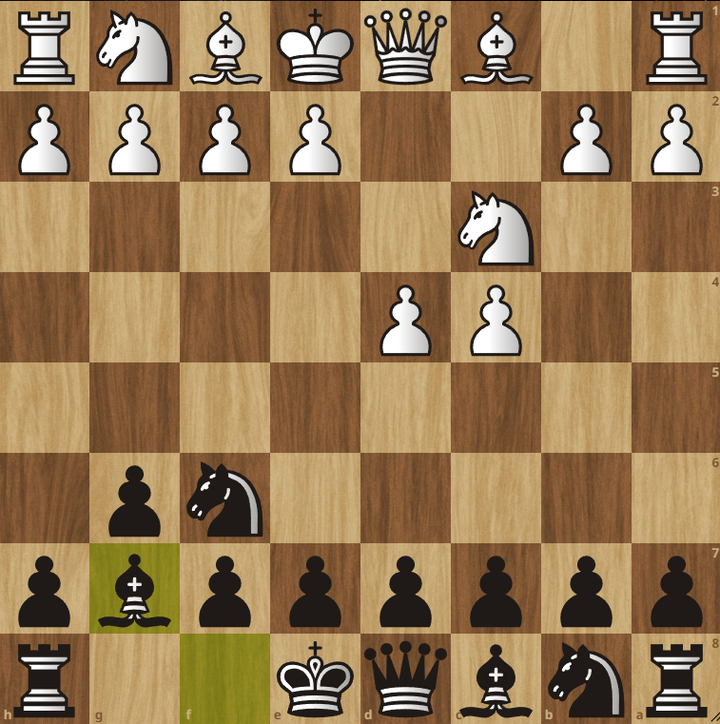
The Kings Indian Defence is the other way to play after 1.d4 Nf6 2.c4 g6 3.Nc3 with 3...Bg7. Here, Black makes no attempt to complicate things in the centre, and instead has other, unorthadox and aggressive plans for the middlegame. Here of course, White plays 4.e4, and Black should stop them from playing 5.e5 (kicking our knight). Though it is possible to play 4...O-O 5.e5 Ne8, I don't recommend it, as it's harder to play, and not as strong - though it could be a good surprise weapon if you're already a strong player. Anyway, I recommend 4...d6, which might not look like it stops 5.e5, but it does (because if 5.e5 dxe5 6.dxe5 Qxd1+ 7.Kxd1 Ng4 winning material (or 7.Nxd1 Nh5 with a better position and f6 incoming)). From the 5th move, White already has so many options that they can play, such as 5.f3 "Saemisch", 5.h3 "Makogonov", 5.f4 "Four Pawns", or 5.Nge2 "Kramer", so Black will have to know lots of theory. But the main lines revolve around one simple idea, to allow White dominant control of the centre with a space advantage, which helps them push through easily on the queenside, but at the same time use the fact that the position is locked up to throw a huge kingside pawn-storm at White which allows for intuitive sacrifices which can often win games very quickly. The Kings Indian is one of the most aggressive all or nothing openings that Black can employ, and it requires a lot of understanding and theory memorization. The main line by the way, continues: 5.Nf3 O-O 6.Be2 e5 7.O-O (White cannot win a pawn ever with 7.dxe5 dxe5 8.Nxe5 because of 8...Nxe4!) 7...Nc6, which provokes the best move: 8.d5. Then after 8...Ne7, there are multiple options such as the aggressive 9.b4 "Bayonet Attack", and 9.Ne1 "Classical System", but either way, Black's plans will be as follows; move the knight from f6 in order to push f5 and f4, then put the knight back in order to push the g and h-pawns up the board too. Preserve the light-squared bishop in order to prevent White from playing h3 (as you would be able to sacrifice the bishop on that square), then attempt to sacrifice in order to open up the king, and calculate to a win. Often, you will need to get the rook involved into the game too, by playing moves like Kh8, Rf7, Bf8, and Rg7. This is a typical maneuver. The opening is seen at the highest level now and then, and was championed by many famous world champions such as Bobby Fischer and Garry Kasparov. It was also played a lot during the famous Candidates Tournament in Zurich, 1953.
Most played line on Lichess (<2000):
1.d4 Nf6 2.c4 g6 3.Nc3 Bg7 4.e4 d6 5.Nf3 O-O 6.Be2 e5 7.O-O Nc6 8.d5 Ne7 (White is slightly better).
Most played Master line (2021-2023):
1.d4 Nf6 2.c4 g6 3.Nc3 Bg7 4.e4 d6 5.Nf3 O-O 6.Be2 e5 7.O-O Nc6 8.d5 Ne7 (White is slightly better).
Section 5.6) 1...Nf6 2.c4 c5 3.d5 e6 "Benoni"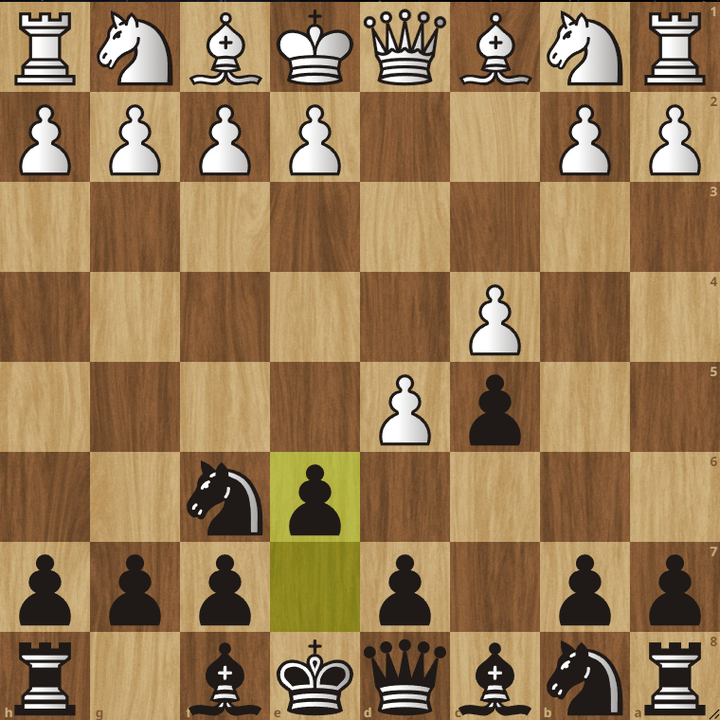
The Benoni is a dynamic and aggressive chess opening that arises after 1.d4 Nf6 2.c4 c5 3.d5 e6. It is characterized by Black's willingness to surrender the center and adopt a counterattacking approach. The Benoni aims to create imbalances and launch a fierce attack against White's pawn structure. By playing ...e6, Black intends to challenge White's central pawns and gain space on the queenside. The Benoni often leads to sharp and tactical positions, with Black relying on active piece play and pawn breaks to generate counterplay. It is a favored choice for players seeking unbalanced and aggressive positions, where strategic planning and tactical resourcefulness are crucial. It actually has one of the highest win rates at the master level, though is very rarely played at the GM level. It was played famously in by Fischer in his 1972 world championship match against Boris Spassky in Game 3 where Black won.
Most played line on Lichess (<2000):
1.d4 Nf6 2.c4 c5 3.d5 e6 4.Nc3 exd5 5.cxd5 d6 6.e4 g6 7.f4 Bg7 8.Bb5+ Nfd7 (White is slightly better).
Most played Master line (2021-2023):
1.d4 Nf6 2.c4 c5 3.d5 e6 4.Nc3 exd5 5.cxd5 d6 6.e4 g6 7.f4 Bg7 8.Bb5+ Nfd7 (White is slightly better).
Section 5.7) 1...Nf6 2.c4 c5 3.d5 b5 "Benko Gambit"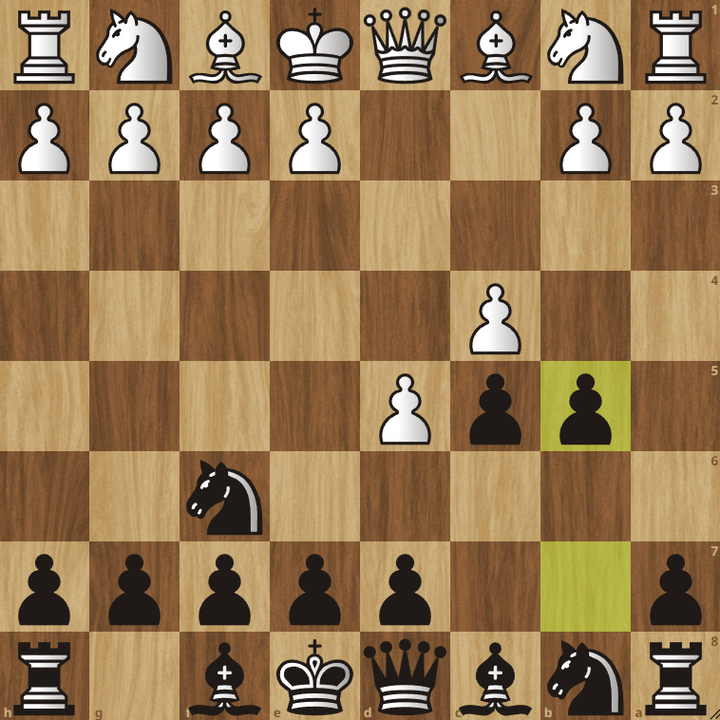
The Benko Gambit (or Volga Gambit) is another way to play from the same start to the Benoni, but after 1.d4 Nf6 2.c4 c5 3.d5, instead of 3...e6, you counterattack in the centre immediately with 3...b5. In the Benko, you gambit the b-pawn to gain long-term strategic compensation and active piece play. By playing ...b5, Black aims to create pressure on White's queenside and exploit the weakened pawn structure. The Benko Gambit often leads to dynamic and imbalanced positions, where Black aims to generate counterplay and initiative. It appeals to players who enjoy playing with the initiative, employing tactical strikes, and putting pressure on the opponent's position, while accepting a temporary material disadvantage. Black is left down a pawn, but with serious initiative along both the queenside and the a1-h8 diagonal. Also Black has no weaknesses, and easy, long term attacking ideas. They will usually play Rfb8, Qa5, d6, Nd7, and then, if they can, c4, Nc5 and Nd3. There are many different ways/move orders that Black can set up the Benko with, but most involve not attempting to win the pawn back, by playing a6 (which White should capture). At the end of the day, Black is down a pawn, so objectively, White is better and if they can hold on to their extra pawn and fight back Black's initiative, then they will likely win. Though, even at the Master level, White can be better the majority of the game, and still easily slip into a loss. One important thing to note is that unlike most other gambits, Black is perfectly happy to trade off the Queens, and even head into an endgame, because the compensation is long-term and on the queenside, as opposed to checkmating the enemy king. Garry Kasparov once reffered to it as "Black's best gambit". But it very rarely gets played at the top level.
Most played line on Lichess (<2000):
1.d4 Nf6 2.c4 c5 3.d5 b5 4.cxb5 a6 5.bxa6 g6 6.Nc3 Bg7 7.e4 O-O 8.Nf3 Qa5 (White is slightly better).
Most played Master line (2021-2023):
1.d4 Nf6 2.c4 c5 3.d5 b5 4.cxb5 a6 5.bxa6 g6 6.Nc3 Bg7 7.e4 O-O 8.a7 Rxa7 (White is slightly better).
Section 5.8) 1...f5 "Dutch"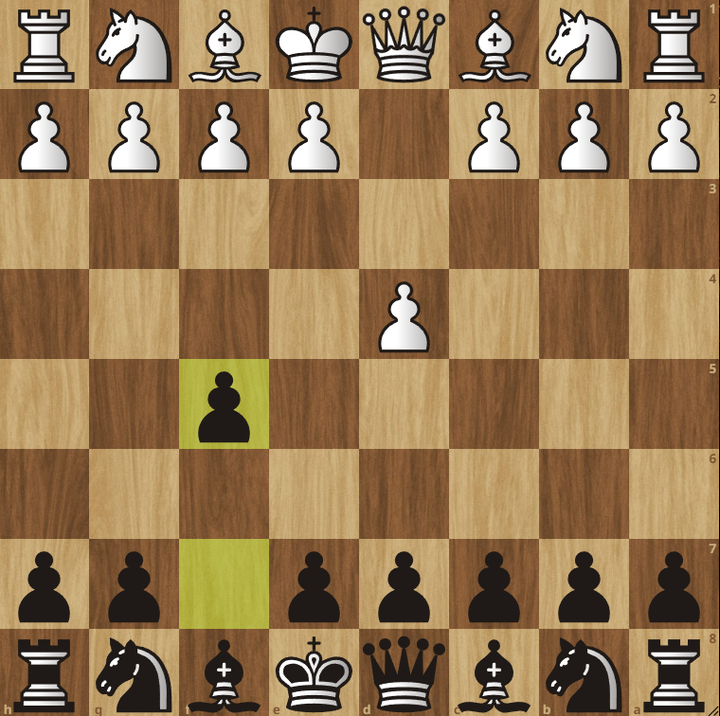
The Dutch Defense is an aggressive and combative chess opening that starts with 1.d4 f5. It aims to create an unbalanced position and put early pressure on White's center. By playing ...f5, Black seeks to control the e4 square and launch a swift kingside attack. The Dutch Defense often leads to dynamic and double-edged positions, where both sides must be prepared for sharp tactical battles. It appeals to players who enjoy aggressive and attacking play, taking the initiative, and challenging White's pawn structure. The Dutch Defense offers an alternative and exciting option for those who want to play for a win with unconventional pawn structures and strategic possibilities. I absolutely do not recommend this to beginners, because it's very hard to play without an f-pawn, as this opens up the h5-d8 diagonal to your king, making defence very tricky. Though, if you're a good player, it can be an excellent and aggressive choice to fight for a win with.
Most played line on Lichess (<2000):
1.d4 f5 2.c4 Nf6 3.Nc3 d6 4.Nf3 g6 5.Bg5 Bg7 6.e3 O-O 7.Bd3 Nc6 8.O-O e5 (Equality).
Most played Master line (2021-2023):
1.d4 f5 2.g3 Nf6 3.Bg2 g6 4.Nf3 Bg7 5.O-O O-O 6.c4 d6 7.Nc3 c6 8.d5 e5 (White is slightly better).
Conclusion
At this point, you should have selected 3 major openings: 1 as White (1.e4 or 1.d4), and 2 as Black (Against both 1.e4 and 1.d4). From here, I would strongly recommend that you play lots of games in the openings that you've chosen - that is the best way to learn them. After your games, understand where you went wrong, and game by game, you will master the opening in time. Below is a list of resources which should help you learn the openings that you have selected.
I hope that this blog has helped you. And if you're interested in getting private coaching, don't hesitate to reach out. Good luck in your chess endeavours!
Resource List:
White
1.1) 1.e4 e5 2.f4:
Kings Gambit:
Famous Game: https://www.chessgames.com/perl/chessgame?gid=1018910
Instructive Video: https://www.youtube.com/watch?v=p8vIHUAZmXc
1.2) 1.e4 e5 2.d4:
Danish Gambit:
Famous Game: https://www.chessgames.com/perl/chessgame?gid=1028156
Instructive Video: https://www.youtube.com/watch?v=Nd7ZiSvdwN8
1.3) 1.e4 e5 2.Nc3:
Vienna Game:
Famous Game: https://www.chessgames.com/perl/chessgame?gid=1228798
Instructive Video: https://www.youtube.com/watch?v=6QQ5sw-SgNw
Vienna Gambit:
Famous Game: https://www.chessgames.com/perl/chessgame?gid=1152032
Instructive Video: https://www.youtube.com/watch?v=JVxENCPcCjU
1.4) 1.e4 e5 2.Nf3 Nc6 3.Bc4:
Italian Game:
Famous Game: https://www.chessgames.com/perl/chessgame?gid=1043992
Instructive Video: https://www.youtube.com/watch?v=0g0mrGTGe-E
1.5) 1.e4 e5 2.Nf3 Nc6 3.Bb5:
Ruy Lopez:
Famous Game: https://www.chessgames.com/perl/chessgame?gid=1268980
Instructive Video: https://www.youtube.com/watch?v=IQrtrPvU3bQ&t
1.6) 1.e4 e5 2.Nf3 Nc6 3.d4:
Scotch Game:
Famous Game: https://www.chessgames.com/perl/chessgame?gid=1253303
Instructive Video: https://www.youtube.com/watch?v=Y-c3WDEIQvw&t
Scotch Gambit:
Famous Game: https://www.chessgames.com/perl/chessgame?gid=1242893
Instructive Video: https://www.youtube.com/watch?v=UApgiHQKemk
1.7) 1.e4 e5 2.Nf3 Nc6 3.c3:
Ponziani:
Famous Game: https://www.chessgames.com/perl/chessgame?gid=1002306
Instructive Video: https://www.youtube.com/watch?v=tqZLFyZbfDk
My FREE Chessable Course: https://www.chessable.com/the-devious-ponziani/course/92093/
2.1) 1.e4 c5 2.Nf3:
Open Sicilian:
Famous Game: https://www.chessgames.com/perl/chessgame?gid=1067858
Instructive Video: https://www.youtube.com/watch?v=4MHicEPcn3c
2.2) 1.e4 c5 2.c3:
Alapin:
Famous Game: https://www.chessgames.com/perl/chessgame?gid=1070874
Instructive Video: https://www.youtube.com/watch?v=VxV8l3x7hOg
2.3) 1.e4 c5 2.Nc3:
Closed Sicilian:
Famous Game: https://www.chessgames.com/perl/chessgame?gid=1469817
Instructive Video: https://www.youtube.com/watch?v=rnm7yXtx6yw&t
2.4) 1.e4 c5 2.d4
Smith-Morra Gambit:
Famous Game: https://www.chessgames.com/perl/chessgame?gid=1630005
Instructive Video: https://www.youtube.com/watch?v=OTcd3onnOWA
3.0) 1.d4 d5 2.c4:
Queens Gambit:
Famous Game: https://www.chessgames.com/perl/chessgame?gid=1067121
Instructive Video: https://www.youtube.com/watch?v=mtsabsZ4wG4
3.1) 1.d4 Nf6 2.c4:
Kings Indian as White:
Famous Game: https://www.chessgames.com/perl/chessgame?gid=1070716
Instructive Video: https://www.youtube.com/watch?v=YZqdLIryamM&t
Benoni as White:
Famous Game: https://www.chessgames.com/perl/chessgame?gid=1110010
Instructive Video: https://www.youtube.com/watch?v=81KPdu9AIWA
Benko Gambit as White:
Famous Game: https://www.chessgames.com/perl/chessgame?gid=1260002
Instructive Video: https://www.youtube.com/watch?v=UyCnYH3azrY
Grunfeld as White:
Famous Game: https://www.chessgames.com/perl/chessgame?gid=1049156
Instructive Video: https://www.youtube.com/watch?v=13wOtGpsksA
Nimzo-Indian as White:
Famous Game: https://www.chessgames.com/perl/chessgame?gid=1031957
Instructive Video: https://www.youtube.com/watch?v=BD2oN6sKlhM
A great Chessable Course: https://www.chessable.com/crush-the-nimzo-indian-defense/course/93968/
Queens Indian as White:
Famous Game: https://www.chessgames.com/perl/chessgame?gid=1387655
Instructive Video: https://www.youtube.com/watch?v=80RomCPmt7E
3.2) 1.d4 2.Bf4 3.e3 4.Nf3:
London System:
Famous Game: https://www.chessgames.com/perl/chessgame?gid=2477747
Instructive Video: https://www.youtube.com/watch?v=VIIpCCsqePk&t
3.3) 1.d4 2.Nc3 3.Bf4:
Jobava London:
Famous Game: https://www.chessgames.com/perl/chessgame?gid=1904004
Instructive Video: https://www.youtube.com/watch?v=2F6Wtv-vVCA
3.4) 1.d4 2.c4 3.g3:
Catalan:
Famous Game: https://www.chessgames.com/perl/chessgame?gid=1472877
Instructive Video: https://www.youtube.com/watch?v=4cP3UJblhH4
3.5) 1.d4 Nf6 2.Bg5:
Trompowsky:
Famous Game: https://www.chessgames.com/perl/chessgame?gid=1049986
Instructive Video: https://www.youtube.com/watch?v=wm-Js2Zgf74
Black
4.0) 1...e5 2.Nf3 Nc6:
Kings Gambit as Black:
Famous Game: https://www.chessgames.com/perl/chessgame?gid=1019162
Instructive Video: https://www.youtube.com/watch?v=zEytN1zSTEE
Danish Gambit as Black:
Famous Game: https://www.chessgames.com/perl/chessgame?gid=1341023
Instructive Video: https://www.youtube.com/watch?v=dEjoCta8oOQ
Vienna as Black:
Famous Game: https://www.chessgames.com/perl/chessgame?gid=1228673
Instructive Video: https://www.youtube.com/watch?v=ZzREMSHsdFs
Ruy Lopez as Black:
Famous Game: https://www.chessgames.com/perl/chessgame?gid=1437581
Instructive Video: https://www.youtube.com/watch?v=VGh6OBrRMpQ&t
Italian as Black:
Famous Game: https://www.chessgames.com/perl/chessgame?gid=1070708
Instructive Video: https://www.youtube.com/watch?v=A7hPEQT2qFY
Scotch as Black:
Famous Game: https://www.chessgames.com/perl/chessgame?gid=1002083
Instructive Video: https://www.youtube.com/watch?v=QPsiOyr3Szs
4.1) 1...e5 2.Nf3 Nf6:
Petrov:
Famous Game: https://www.chessgames.com/perl/chessgame?gid=1064746
Instructive Video: https://www.youtube.com/watch?v=dqw3pBmR8io
4.2) 1...c5 2.Nf3 d6:
Najdorf:
Famous Game: https://www.chessgames.com/perl/chessgame?gid=1333302
Instructive Video: https://www.youtube.com/watch?v=QuL191Z3vAo
Dragon:
Famous Game: https://www.chessgames.com/perl/chessgame?gid=1018626
Instructive Video: https://www.youtube.com/watch?v=WA7BwI6xTzQ
Classical:
Famous Game: https://www.chessgames.com/perl/chessgame?gid=1060694
Instructive Video: https://www.youtube.com/watch?v=bBoN5PB1GYg
Scheveningen:
Famous Game: https://www.chessgames.com/perl/chessgame?gid=1067179
Instructive Video: https://www.youtube.com/watch?v=kmPf2mwFK2Y
4.3) 1...c5 2.Nf3 Nc6:
Accelerated Dragon:
Famous Game: https://www.chessgames.com/perl/chessgame?gid=1072759
Instructive Video: https://www.youtube.com/watch?v=h11MkaA32Vo
Sveshnikov:
Famous Game: https://www.chessgames.com/perl/chessgame?gid=1956633
Instructive Video: https://www.youtube.com/watch?v=oTJiIRwULwk&t
4.4) 1...c5 2.Nf3 e6:
Taimanov:
Famous Game: https://www.chessgames.com/perl/chessgame?gid=1111195
Instructive Video: https://www.youtube.com/watch?v=q-Mzn45iCeg&t
Kan:
Famous Game: https://www.chessgames.com/perl/chessgame?gid=1008424
Instructive Video: https://www.youtube.com/watch?v=a_pMtJJLElw
4.5) 1...e6:
French:
Famous Game: https://www.chessgames.com/perl/chessgame?gid=1094915
Instructive Video: https://www.youtube.com/watch?v=5pec-u6PSvA
4.6) 1...c6:
Caro-Kann:
Famous Game: https://www.chessgames.com/perl/chessgame?gid=1007846
Instructive Video: https://www.youtube.com/watch?v=ebfzL_GwiIE&t
4.7) 1...d5:
Scandinavian:
Famous Game: https://www.chessgames.com/perl/chessgame?gid=1121125
Instructive Video: https://www.youtube.com/watch?v=KNKCDRfBfII
4.8) 1...d6:
Pirc:
Famous Game: https://www.chessgames.com/perl/chessgame?gid=1125543
Instructive Video: https://www.youtube.com/watch?v=pEQdCWwH-YU
4.7) 1...Nf6:
Alekhine:
Famous Game: https://www.chessgames.com/perl/chessgame?gid=1128889
Instructive Video: https://www.youtube.com/watch?v=AnexVs5_Gl0
5.0) 1...d5 2.c4 e6:
Queens Gambit Declined:
Famous Game: https://www.chessgames.com/perl/chessgame?gid=1261680
Instructive Video: https://www.youtube.com/watch?v=x4jk0r3AY0w
5.1) 1...d5 2.c4 c6:
Slav:
Famous Game: https://www.chessgames.com/perl/chessgame?gid=1430952
Instructive Video: https://www.youtube.com/watch?v=_oBGJrjvbKw
Semi-Slav:
Famous Game: https://www.chessgames.com/perl/chessgame?gid=1262430
Instructive Video: https://www.youtube.com/watch?v=TJoDGHZ9R28
5.2) 1...d5 2.c4 dxc4:
Queens Gambit Accepted:
Famous Game:https://www.chessgames.com/perl/chessgame?gid=1018413
Instructive Video: https://www.youtube.com/watch?v=KTOBXStvXLc
5.3) 1...Nf6 2.c4 e6:
Nimzo-Indian:
Famous Game: https://www.chessgames.com/perl/chessgame?gid=1128896
Instructive Video: https://www.youtube.com/watch?v=ZHzl8RpUyRo
Queens Indian:
Famous Game: https://www.chessgames.com/perl/chessgame?gid=1102400
Instructive Video: https://www.youtube.com/watch?v=0RlupWm5Iao
Bogo-Indian:
Famous Game: https://www.chessgames.com/perl/chessgame?gid=1129505
Instructive Video: https://www.youtube.com/watch?v=bo8xD3y_NIA
5.4) 1...Nf6 2.c4 g6 3.Nc3 d5:
Grunfeld:
Famous Game: https://www.chessgames.com/perl/chessgame?gid=1143956
Instructive Video: https://www.youtube.com/watch?v=JheXw9rvgZw
5.5) 1...Nf6 2.c4 g6 3.Nc3 Bg7:
Kings Indian:
Famous Game: https://www.chessgames.com/perl/chessgame?gid=1567841
Instructive Video: https://www.youtube.com/watch?v=iGCSfVDYhh0&t
5.6) 1...Nf6 2.c4 c5 3.d5 e6:
Benoni:
Famous Game: https://www.chessgames.com/perl/chessgame?gid=1139346
Instructive Video: https://www.youtube.com/watch?v=R3sT1d_npnQ
5.7) 1...Nf6 2.c4 c5 3.d5 b5:
Benko Gambit:
Famous Game: https://www.chessgames.com/perl/chessgame?gid=1745716
Instructive Video: https://www.youtube.com/watch?v=6VoeKiq-C3Q
5.8) 1...f5:
Dutch:
Famous Game: https://www.chessgames.com/perl/chessgame?gid=1012099
Instructive Video: https://www.youtube.com/watch?v=ogmGNIk6W7I
More blog posts by TheLastStyleBender
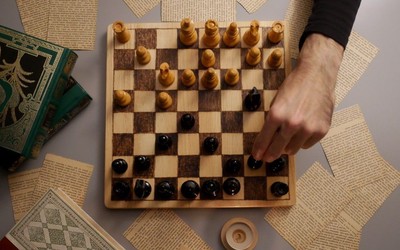
The Opening Guide
In an earlier blog (The Opening Anthology), I wrote a guide which read like a CYOA . However, admitt…
Deriving a Chess Style from your Learning Style
This test was designed for anyone to quickly determine which openings best suit them based off of th…
Monthly Notables
I made a study where I take a look at 5 of the most entertaining games from 1 player, once a month.
